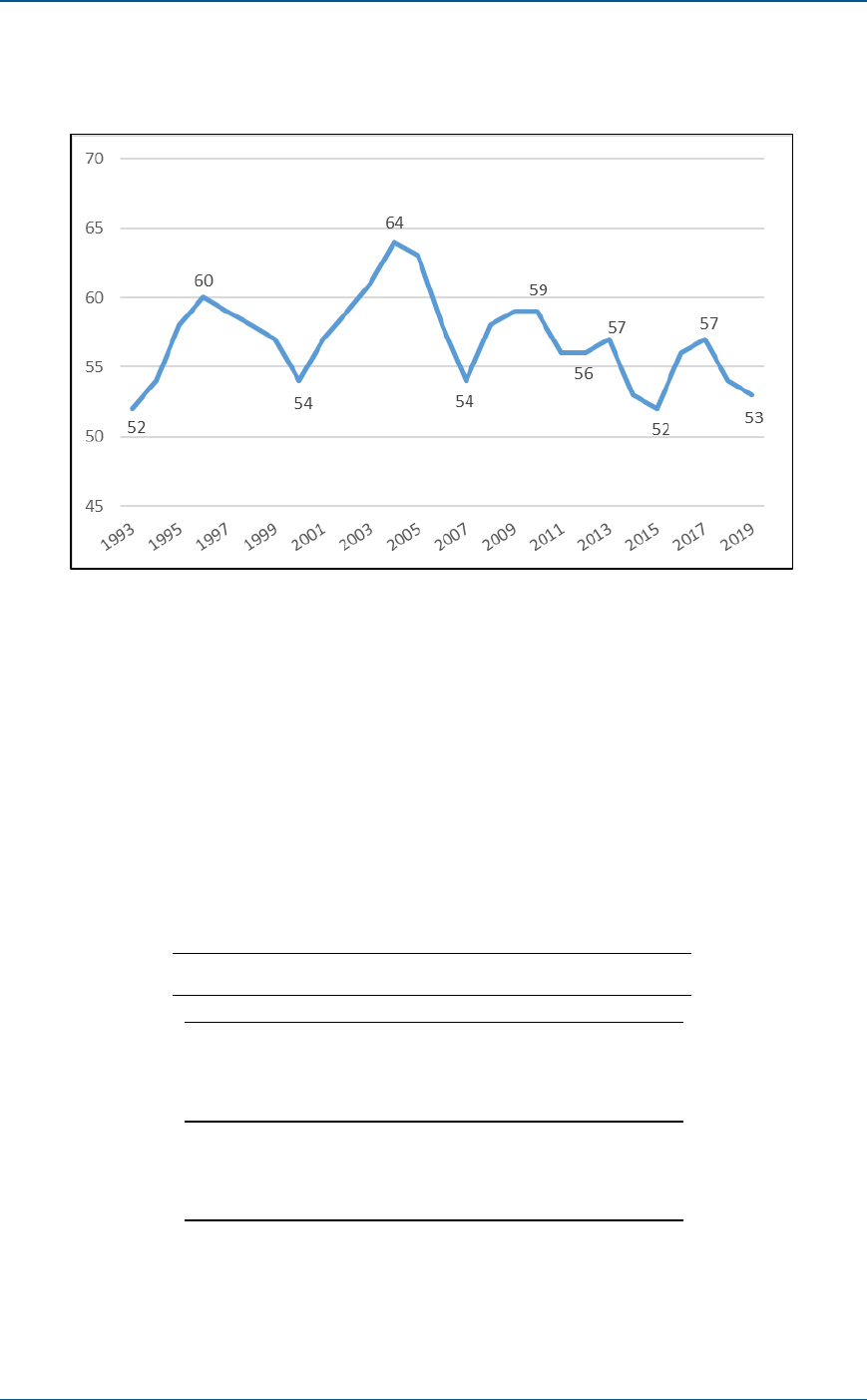
Public Trust and Law Enforcement—
A Discussion for Policymakers
Updated July 13, 2020
Congressional Research Service
https://crsreports.congress.gov
R43904

Congressional Research Service
SUMMARY
Public Trust and Law Enforcement—
A Discussion for Policymakers
Several high-profile incidents where there have been complaints of the use of excessive force
against individuals and subsequent backlash in the form of civil unrest have generated interest in
what role Congress could play in facilitating efforts to build trust between the police and the
people they serve. This report provides an overview of the federal government’s role in local
police-community relations.
According to polling conducted by Gallup, public confidence in the police declined in 2014 and
2015 after several high-profile incidents in which men of color were killed during confrontations
with the police. Confidence in the police rebounded back to the historical average in 2017 before
declining again in 2018 and 2019. (Gallup data are not yet available for 2020). However, certain
groups, such as people of color, people age 34 or younger, and individuals who identify as liberal
say they have less confidence in the police than whites, people over the age of 35, and people
with conservative political leanings.
Some observers believe that a decline in public trust of the police is at least partially attributable
to state and local police policies and practices. Federalism limits the amount of influence
Congress can have over state and local law enforcement policy. General policing powers are the
purview of states, but Congress can try to influence state and local policing policies by attaching
conditions to grant funds.
The federal government might also choose to address issues related to police-community
relations and accountability through (1) federal efforts to collect and disseminate data on the use
of force by police, (2) statutes that allow the federal government to investigate instances of
alleged police misconduct, and (3) the influence the Department of Justice (DOJ) has on state and
local policing through its role as a public interest law enforcer, policy leader, and convener of representatives from law
enforcement agencies and local communities to discuss policing issues.
There are several options policymakers might consider should they choose to play a role in facilitating better police-
community relations, including the following:
placing conditions on federal funding to encourage law enforcement agencies to adopt policies that
promote better community relations;
promoting efforts to collect data on the use of force by law enforcement, including evaluating potential
overlap between DOJ programs that currently collect the data;
providing grants to law enforcement agencies so they can purchase body-worn cameras for their officers;
taking steps to facilitate investigations and prosecutions of excessive force by amending 18 U.S.C. Section
242 to reduce the mens rea standard in federal prosecution, enhance DOJ civil enforcement under 34
U.S.C. Section 12601, or place conditions on federal funds to promote the use of special prosecutors at the
state level;
funding Community Oriented Policing Services (COPS) grants so law enforcement agencies can hire more
officers to engage in community policing activities; and
using the influence of congressional authority to affect the direction of national criminal justice policy.
R43904
July 13, 2020
Nathan James,
Coordinator
Analyst in Crime Policy
Kristin Finklea
Specialist in Domestic
Security
Whitney K. Novak
Legislative Attorney
Joanna R. Lampe
Legislative Attorney
April J. Anderson
Legislative Attorney
Kavya Sekar
Analyst in Health Policy

Public Trust and Law Enforcement—A Discussion for Policymakers
Congressional Research Service
Contents
Public Perception of the Police .......................................................................................... 1
Federalism and Congressional Influence over State and Local Law Enforcement Policy ............ 3
Overview of Federalism ............................................................................................. 3
Spending Power and Regulating Law Enforcement Activities ........................................... 4
Section 5 of the Fourteenth Amendment and Regulating Law Enforcement Activities .......... 5
Federal Efforts to Collect Data on Law Enforcement Officers’ Use of Force............................. 8
The Federal Bureau of Investigation’s Use of Force Data Collection ................................. 8
Death in Custody Reporting Program............................................................................ 9
Contacts between the Police and the Public ................................................................. 12
Data from the Centers for Disease Control and Prevention ............................................. 12
Authority for DOJ to Investigate Law Enforcement Misconduct ........................................... 14
What Roles Can the Department of Justice Play in Improving Police-Community
Relations? ................................................................................................................. 18
DOJ as Policy Leader ............................................................................................... 18
DOJ as Law Enforcer ............................................................................................... 20
DOJ as Convener..................................................................................................... 21
Policy Options for Congress ........................................................................................... 22
Conditions on Federal Funding .................................................................................. 23
Data on Police Use of Force ...................................................................................... 24
Promoting the Use of Body-Worn Cameras ................................................................. 25
Facilitating the Investigation and Prosecution of Excessive Force ................................... 27
Promoting Community Policing ................................................................................. 28
Non-legislative Measures.......................................................................................... 31
Figures
Figure 1. Overall Confidence in the Police, 1993-2019 ......................................................... 2
Tables
Table 1. Confidence in the Police, by Demographic Group, 2019............................................ 2
Contacts
Author Information ....................................................................................................... 32

Public Trust and Law Enforcement—A Discussion for Policymakers
Congressional Research Service 1
everal high-profile incidents where police officers have been involved in the deaths of
individuals have reinvigorated a discussion about how the police use force against
minorities and the tension that exists between police officers
1
and minority communities.
The national debate about how police use force and police-community relations might generate
interest among policymakers about what role Congress could play in facilitating efforts to build
trust between the police and the people they serve, as well as police accountability for any
excessive use of force.
The report starts with an overview of data on public opinion of the police. It then provides a brief
discussion of federalism and why Congress does not have the authority to directly change state
and local law enforcement practices. Next, the report reviews federal efforts to collect data on law
enforcement agencies’ use of force and federal authority to investigate instances of police
misconduct. This is followed by a review of what role DOJ might be able to play in facilitating
improvements in police-community relations or making changes in state and local law
enforcement agencies’ policies. The report concludes with policy options for Congress to consider
should policymakers decide to exert some influence on state and local law enforcement agencies’
policy.
The Parameters of This Report
This report provides a brief overview of police-community relations and how policymakers might be able to
promote improved relationships between the police and their constituents, especially people of color. The report
focuses solely on the relationship between the police and the communities they serve. It does not include a
discussion of the level of trust in or perceived bias by other parts of the criminal justice system (e.g., the grand jury
system, prosecutions, or corrections). The report also focuses on issues related to state and local law enforcement
agencies and not federal law enforcement agencies. It focuses on state and local law enforcement agencies because
congressional interest in law enforcement reform has largely centered on what role Congress might play in
promoting a better relationships between state and local law enforcement agencies and their communities and how
Congress could promote more accountability for state and local law enforcement officers’ use of excessive force.
Public Perception of the Police
Gallup, whose polling tracks confidence in a variety of institutions, found that 53% of Americans
said they had a “great deal” or “quite a lot” of confidence in the police in 2019 (see Figure 1).
2
Only the military (73%) and small business (68%) had greater percentages of respondents voicing
confidence in the respective institutions than the police in 2019.
3
1
Police departments and police officers are a subset of all law enforcement agencies, which include sheriff’s offices,
state law enforcement agencies (e.g., state troopers), and special-jurisdiction law enforcement agencies (e.g., transit
police or university police departments). However, police and law enforcement agencies will be used interchangeably
in this report.
2
Polling data from 2019 is the most recent available. Justin McCarthy, “U.S. Confidence in Organized Religion
Remains Low,” Gallup, July 8, 2019. Full data are linked in the article at https://news.gallup.com/file/poll/260033/
190708ConfidenceInstitutions.pdf.
3
Ibid.
S

Public Trust and Law Enforcement—A Discussion for Policymakers
Congressional Research Service 2
Figure 1. Overall Confidence in the Police, 1993-2019
Percentage who report a “great deal” or “quite a lot” of confidence in the police
Source: Justin McCarthy, “U.S. Confidence in Organized Religion Remains Low,” Gallup, July 8, 2019. Full data
are linked in the article at https://news.gallup.com/file/poll/260033/190708ConfidenceInstitutions.pdf.
Notes: Data markers in the figure indicate points at which the reported confidence levels switch directions.
Confidence in the police varies by race, gender, political ideology/party affiliation, age, and
education level (see Table 1). For example, whites were more likely to say that they have a “great
deal” or “quite a lot” of confidence in the police than non-whites. Variability in confidence is also
evidenced among people who identify as conservative, moderate, or liberal. Conservatives are
more likely than liberals and moderates to have confidence in the police. In addition, a smaller
proportion of people ages 18-34 said they were confident in the police compared to people ages
35-54 and people 55 and older, with the 55 and older group having the greatest proportion of
people saying that they had a “great deal” or “quite a lot” of confidence in the police.
Table 1. Confidence in the Police, by Demographic Group, 2019
Percentage who report a “great deal” or “quite a lot” of confidence in the police
Demographic Group
Race
White
59%
Non-white
40%
Gender
Male
56%
Female
49%
Political Ideology
Liberal
33%
Moderate
46%
Conservative
75%

Public Trust and Law Enforcement—A Discussion for Policymakers
Congressional Research Service 3
Demographic Group
Age
18-34
39%
35-54
53%
55 or older
63%
Education
High school grad or less
48%
Some college
54%
College grad
55%
Source: CRS presentation of data from Justin McCarthy, “U.S. Confidence in Organized Religion Remains Low,”
Gallup, July 8, 2019; full data are linked in the article at https://news.gallup.com/file/poll/260033/
190708ConfidenceInstitutions.pdf.
A poll conducted by National Public Radio, the Public Broadcasting Service, and the Maris t
Institute for Public Opinion from June 2 to June 3, 2020 (which was after George Floyd’s death in
Minneapolis) found that 63% of respondents have a great deal or a fair amount of confidence that
the police treat blacks and whites equally.
4
In comparison, 71% of respondents had a great deal or
fair amount of confidence that the police treat blacks and whites equally when they were asked a
similar question in December 2014. Perceptions of how the police treat blacks and whites varies
by race/ethnicity. In the June 2020 poll, 70% of white respondents had a great deal or fair amount
of confidence that the police treat blacks and whites equally while 31% of African Americans and
63% of Latinos had the same amount of confidence that the police treat blacks and whites
similarly.
Federalism and Congressional Influence over State
and Local Law Enforcement Policy
Policymakers may have an interest in legislation that aims to help increase trust between state and
local police and certain communities. However, federalism principles limit the influence
Congress has over state and local law enforcement policies.
Overview of Federalism
Federalism describes the intergovernmental relationships between and among federal, state, and
local governments, with the federal government having primary authority in some areas and state
and local governments having primary authority in other areas.
5
The Constitution establishes a
“system of dual sovereignty between the States and the Federal Government.”
6
Under the Tenth
Amendment, “[t]he powers not delegated to the United States by the Constitution, nor prohibited
4
Polling data available at http://maristpoll.marist.edu/wp -content/uploads/2020/06/NPR_PBS-NewsHour_Marist-
Poll_USA-NOS-and-Tables_2006041039.pdf.
5
James Q. Wilson and John J. Dilulio, Jr, American Government Institutions and Policies (Lexington, MA: D.C. Heath
and Company, 1995), p. A-49.
6
Gregory v. Ashcroft, 501 U.S. 452, 457 (1991).

Public Trust and Law Enforcement—A Discussion for Policymakers
Congressional Research Service 4
by it to the States, are reserved to the States respectively, or to the people.”
7
Thus, a state
generally has broad authority to enact legislation, including to regulate the state’s and its
localities’ law enforcement approaches.
8
In contrast, Congress may only enact legislation under a
specific power that is enumerated in the Constitution and cannot use its power to intrude
impermissibly on the sovereign powers of the states.
9
In this vein, the Supreme Court has
recognized that there are certain subjects that are largely of a local concern where states
“historically have been sovereign,” such as issues related to the family, crime, and education.
10
Because of these principles, the Supreme Court has recognized various limitations on Congress’s
power to legislate in areas that fall within a state’s purview, observing that congressional power is
“subject to outer limits,” and that Congress must take care not to “effectually obliterate the
distinction between what is national and what is local.”
11
In addition, under the anti-
commandeering doctrine, Congress is prohibited from passing laws requiring states or localities
to adopt or enforce federal policies.
12
Although these principles constrain Congress’s power, it
can rely on its enumerated powers to regulate in areas it could not otherwise reach.
13
The
spending power and Section 5 of the Fourteenth Amendment are two of the most relevant
authorities that Congress has used in the past to address local law enforcement issues.
Spending Power and Regulating Law Enforcement Activities
The Spending Clause empowers Congress to “lay and collect Taxes, Duties, Imposts, and Excises,
to pay the Debts and provide for the common Defence and general Welfare of the United
States.”
14
The Supreme Court has held that incident to the spending power, Congress may further
its policy objectives by attaching conditions on the receipt of federal funds.
15
These conditions
often involve compliance with statutory or administrative directives and can apply to any entity
receiving federal funds, including states and localities. In South Dakota v. Dole, for example, the
Supreme Court upheld as a valid exercise of Congress’s spending power a statute that conditioned
the grant of federal highway funds to any state upon that state prohibiting the legal purchase or
possession of alcohol by individuals less than 21 years old.
16
There are, however, four limitations on Congress’s authority to attach conditions to federal
funds.
17
First, a funding condition must be “in pursuit of the general welfare.”
18
However, courts
afford Congress substantial deference in determining what expenditures are “intended to serve
7
U.S. CONST. amend. X.
8
See Bond v. United States, 572 U.S. 844, 854 (2014).
9
Murphy v. Nat'l Collegiate Athletic Ass'n, 138 S.Ct. 1461, 1467 (2018) (“The Constitution confers on Congress not
plenary legislative power but only certain enumerated powers.”); United States v. Morrison, 529 U.S. 598, 607 (2000)
(“Every law enacted by Congress must be based on one or more of its powers enumerated in the Constitution.”).
10
United States v. Lopez, 514 U.S. 549, 564 (1995).
11
Ibid. at 557.
12
New York v. United States, 505 U.S. 144, 188 (1992).
13
South Dakota v. Dole, 483 U.S. 203, 207 (1987) (“[O]bjectives not thought to be within Article I’s enumerated
legislative fields ... may nevertheless be attained through the use of the spending power and the conditional grant of
federal funds.”) (internal citations and quotations omitted).
14
U.S. CONST. art. I, §8, cl. 1.
15
Dole, 483 U.S. at 206.
16
Ibid. at 211-212.
17
See CRS Report R45323, Federalism-Based Limitations on Congressional Power: An Overview, pp. 28-35.
18
Dole, 483 U.S. at 207.

Public Trust and Law Enforcement—A Discussion for Policymakers
Congressional Research Service 5
general public purposes.”
19
Second, if Congress intends to place conditions on federal funds, it
must do so “unambiguously” so that states can knowingly choose whether or not to accept the
funds.
20
Third, conditions on federal funding must be related or “germane” to “the federal interest
in particular national projects or programs.”
21
Fourth, other constitutional provisions may bar the
conditions placed on the grant of federal funds. For instance, Congress may not condition a
monetary grant on “discriminatory state action or the infliction of cruel and unusual
punishment.”
22
Relatedly, conditions on federal funding are unconstitutional when they become
coercive to the point that “pressure turns into compulsion” or commandeering.
23
For example, in
National Federation of Independent Business (NFIB) v. Sebelius, the Supreme Court held that a
provision in the Affordable Care Act that withheld all Medicaid grants from any state that refused
to accept expanded Medicaid funding was unconstitutionally coercive because it threatened to
terminate “significant independent grants” that were already provided to the states.
24
Courts have rarely used these spending power limitations to invalidate conditions placed on the
receipt of federal funds.
25
NFIB remains the only instance in the modern era of the Supreme Court
invalidating an exercise of the congressional spending power.
26
Post-NFIB Spending Clause
challenges have largely been unsuccessful in the lower courts.
27
As a result, in practice Congress
has faced relatively few limitations on its use of the spending power to impose conditions on
federal funds to further its policy objectives.
Section 5 of the Fourteenth Amendment and Regulating Law
Enforcement Activities
The Fourteenth Amendment, in relevant part, provides that no state shall “deprive any person of
life, liberty, or property, without due process of law” or “deny to any person within its jurisdiction
the equal protection of the laws.”
28
The Supreme Court has interpreted the substantive component
of the Due Process Clause as incorporating against state actors nearly all the rights found in the
19
Ibid.
20
Ibid.
21
Ibid.
22
Ibid. at 210.
23
Ibid. at 211.
24
National Federation of Independent Business v. Sebelius, 567 U.S. 519, 580 (2012).
25
Aziz Z. Huq, Tiers of Scrutiny in Enumerated Powers Jurisprudence, 80 U. CHI. L. REV. 575, 599 (2013) (observing
that the Supreme Court has generally “ declined to enforce ‘direct’ limits on the Spending Power”); see also Jonathan H.
Adler and Nathaniel Stewart, Is the Clean Air Act Unconstitutional? Coercion, Cooperative Federalism and
Conditional Spending After NFIB v. Sebelius, 43 ECOLOGY L.Q. 671, 700 (2016); (arguing that the “ NFIB plurality did
not open a new line of attack against spending power statutes.”).
26
Andrew B. Coan, Judicial Capacity and the Conditional Spending Paradox, 2013 WIS. L. REV. 339, 346 (2013)
(“Prior to NFIB, Butler was the only time the Supreme Court ever invalidated an exercise of the congressional spending
power.”).
27
See, for example, Miss. Comm'n on Envtl. Quality v. EPA, 790 F.3d 138, 175 (D.C. Cir. 2015) (rejecting the
plaintiff’s position that the “Clean Air Act’s sanctions for noncompliant states impose such a steep price that State
officials effectively have no choice but to comply”); T exas v. EPA, 726 F.3d 180, 197 (D.C. Cir. 2013) (rejecting the
argument that the challenged federal law was of the “same magnitude and nature as the Medicaid expansion provision
[at issue in NFIB] that would strip over 10 percent of a State’s overall budget”) (internal citations and quotations
omitted); T ennessee v. United States Dep’t of State, 329 F. Supp. 3d 597, 626 -29 (W.D. Tenn. 2018) (rejecting the
argument that the threatened loss of federal Medicaid funding to coerce support of the federal refugee program was
comparable to the program at issue in NFIB).
28
U.S. CONST. amend. XIV.

Public Trust and Law Enforcement—A Discussion for Policymakers
Congressional Research Service 6
Bill of Rights, including those that pertain to criminal procedure and regulate the conduct of the
police.
29
In turn, Section 5 of the Fourteenth Amendment grants Congress the power to enforce
the Amendment through “appropriate legislation.”
30
Section 5’s “positive grant of legislative
power” authorizes Congress to both deter and remedy constitutional violations; and in doing so,
Congress may prohibit otherwise constitutional conduct that intrudes into “legislative spheres of
autonomy previously reserved to the States.”
31
The Section 5 enforcement power (and the
enforcement powers found in the Thirteenth
32
and Fifteenth
33
Amendments) has been used to, for
example, ban the use of literacy tests
34
in state and national elections and abolish “all badges and
incidents of slavery”
35
by banning racial discrimination in the acquisition of real and personal
property. Congress has also used its Section 5 power
36
to provide remedies for the deprivation of
constitutional rights. For example, 42 U.S.C. Section 1983 provides a private cause of action for
individuals claiming that their constitutional rights were violated by state actors acting pursuant
to state law. And 18 U.S.C. Section 242—the current version of which is a product of Congress’s
Section 5 power
37
—imposes criminal liability on state actors who deprive individuals of their
constitutional rights.
While Congress’s Section 5 enforcement power is broad, it is not unlimited.
38
Section 5 allows
Congress to directly enforce constitutional rights through laws like Section 1983 and Section 242;
however, the power does not allow Congress to supplement those rights through prophylactic
legislation that regulates state and local matters without evidence of a history and pattern of past
constitutional violations by the state.
39
And, according to the Supreme Court, when Congress
exercises its Section 5 authority, its response must be congruent and proportional to a
demonstrated harm.
40
Congress may justify the need for Section 5 legislation by establishing a
legislative record that shows “evidence … of a constitutional wrong.”
41
For example, in holding
that Congress exceeded its Section 5 authority in enacting the Religious Freedom Restoration Act
(RFRA)—which, in relevant part, supplanted normal First Amendment standards to impose a
heightened standard of review for state government actions that substantially burdened a person’s
religious exercise—the Supreme Court determined that Congress had failed to establish a
widespread pattern of religious discrimination by the states.
42
As a result, RFRA could not be
justified as a remedial measure designed to prevent unconstitutional conduct and was outside of
29
Timbs v. Indiana, 139 S.Ct. 682, 687 (2019).
30
U.S. CONST. amend. XIV, §8.
31
City of Boerne v. Flores, 521 US 507, 517–18 (1997).
32
U.S. CONST. amend. XII, §2.
33
Ibid. amend. XV, §3.
34
Oregon v. Mitchell, 400 U.S. 112, 118 (1970).
35
Jones v. Alfred H. Mayer Co., 392 U.S. 409, 439 (1968).
36
Monroe v. Pape, 365 U.S. 167, 171 (1961).
37
Screws v. United States, 325 U.S. 91, 98 (1945).
38
City of Boerne v. Flores, 521 U.S. 507, 519 (1997).
39
Northwest Austin Mun. Utility Dist. v. Holder, 557 US 193, 225 (2009).
40
City of Boerne, 521 U.S. at 510.
41
Allen v. Cooper, 140 S.Ct. 994, 1004 (2020).
42
City of Boerne, 521 U.S. at 532.

Public Trust and Law Enforcement—A Discussion for Policymakers
Congressional Research Service 7
Congress’s power over the states.
43
Thus, the Court struck down the law in so far as it applied to
the states.
44
As a consequence of this case law, the scope of Congress’s Section 5 power hinges in part on the
scope of the constitutional right that a given law aims to protect. With respect to regulating state
and local police forces, one constitutional right that may be particularly relevant to Congress ’s
use of its Section 5 power is the Fourth Amendment, which prohibits unreasonable searches and
seizures by the government.
45
The Fourth Amendment applies to many situations involving law
enforcement, including when police stop an individual on the street for questioning,
46
conduct
traffic stops,
47
or make an arrest.
48
Police violate the Fourth Amendment, for example, if they use
excessive force during an investigatory stop or arrest.
49
According to the Supreme Court, the
force used by law enforcement during an investigatory stop or arrest violates the constitution
when it is unreasonable considering the facts and circumstances of the case.
50
This analysis
requires a careful balancing of “the nature and quality of the intrusion on the individual’s Fourth
Amendment interests against the importance of the governmental interests alleged to justify the
intrusion.”
51
For example, the Supreme Court has held that police use of deadly force against a
fleeing suspect who poses no immediate safety threat is unreasonable in violation of the Fourth
Amendment.
52
Determining whether an act of force is excessive in violation of the Constitution,
however, requires a fact-specific analysis—a certain act may be reasonable under some facts,
while in a different case the same act may amount to excessive force. For example, some courts
have ruled that police use of a chokehold is objectively unreasonable when used against
individuals who are already under restraint and not a danger to others.
53
In other circumstances,
courts have upheld police use of a chokehold as reasonable in instances where an individual was
unrestrained and continued to pose a threat of serious harm.
54
Notwithstanding the limits on how much influence the federal government can have on state and
local law enforcement policy, the federal government does have various tools that might be used
to promote better police-community relations and accountability. These include (1) federal efforts
to collect and disseminate data on the use of force by law enforcement officers; (2) statutes that
allow the federal government to investigate instances of police misconduct; and (3) the influence
DOJ has on state and local law enforcement policies through its role as a public interest law
enforcer, policy leader, and convener of law enforcement agencies.
43
Ibid.
44
Ibid. at 536.
45
U.S. CONST. amend. IV.
46
Terry v. Ohio, 392 U.S. 1, 9 (1968).
47
Rodriguez v. United States, 575 U.S. 348, 354 (2015).
48
United States v. Watson, 423 U.S. 411, 417 (1976).
49
Graham v. Connor, 490 U.S. 386, 394 (1989).
50
Ibid. at 396.
51
Tennessee v. Garner, 471 U.S. 1, 7–8 (1985).
52
Ibid. at 11.
53
Coley v. Lucas County, Ohio, 799 F. 3d 530, 540 (6
th
Cir. 2015).
54
Williams v. City of Cleveland, Miss., 736 F. 3d 684, 688 (4
th
Cir. 2013).

Public Trust and Law Enforcement—A Discussion for Policymakers
Congressional Research Service 8
Federal Efforts to Collect Data on Law Enforcement
Officers’ Use of Force
The high-profile deaths of several members of the public at the hands of police officers has
generated questions about why the federal government does not collect and publish data on the
use of force by law enforcement officers. Former Philadelphia Police Chief Charles Ramsey, one
of the co-chairs of the Obama Administration’s Task Force on 21
st
Century Policing, stated
“personally, I think [how data on civilian and law enforcement officers’ deaths are collected]
ought to be pretty much the same. If you don’t have the data, people think you are hiding
something.... This is something that comes under the header of establishing trust.”
55
It may be that
the lack of reliable data on how often police use force and who is the subject of the use of force
fuels the public’s mistrust of the police. Without more comprehensive data to provide context in
this area, the public is left to rely on media accounts of excessive force cases for information. The
lack of comprehensive federal data on police-involved deaths led the Washington Post in 2015 to
start its own database of people who have been shot and killed by the police nationally.
56
The federal government has several data collection efforts that could be used to provide insight
into how the police use force, but these programs are limited by either not collecting data on all
instances where police use force, or by still being in their infancy. The FBI has undertaken an
effort to collect and report more comprehensive data on the use of force by law enforcement
officers through its Use of Force Data Collection program. The Bureau of Justice Assistance
(BJA)
57
also started requiring states to submit data to them that is required by the Death in
Custody Reporting Act of 2013 (P.L. 113-242). The Bureau of Justice Statistics (BJS) continues
to periodically collect and report data on non-fatal contacts between the police and the public
through its Police Public Contact Survey, and the Centers for Disease Control and Prevention
(CDC) collects data on violent deaths due to legal interventions through its National Vital
Statistics and National Violent Death Reporting Systems.
The Federal Bureau of Investigation’s Use of Force Data Collection
The FBI launched its Use of Force Data Collection program on January 1, 2019. The bureau
notes,
Law enforcement use of force has long been a topic of national discussion, but a number
of high-profile cases involving law enforcement use of force have heightened awareness
of these incidents in recent years. However, the opportunity to analyze information related
to use-of-force incidents and to have an informed dialogue is hindered by the lack of
nationwide statistics. To address the topic, representatives from major law enforcement
55
Kevin Johnson, “Panel to Consider T racking of Civilians Killed by Police,” USA Today, December 12, 2014.
56
The Washington Post has collected and reported data on police-involved shootings that resulted in death by “culling
local news reports, law enforcement websites and social media, and by monitoring independent databases such as
Killed by Police and Fatal Encounters.” Data on police shooting deaths for the years 2015-2020 can be accessed at
https://www.washingtonpost.com/graphics/investigations/police-shootings-database/. The Washington Post describes
its methodology for collecting these data at https://www.washingtonpost.com/national/how-the-washington-post-is-
examining-police-shootings-in-the-united-states/2016/07/07/d9c52238-43ad-11e6-8856-f26de2537a9d_story.html.
57
BJA, a bureau in the Office of Justice Programs of the U.S. Department of Justice, provides leadership and assistance
to local criminal justice programs that improve and reinforce the nation’s criminal justice system. BJA’s goals are to
reduce and prevent crime, violence, and drug abuse and to improve the way in which the criminal justice system
functions.

Public Trust and Law Enforcement—A Discussion for Policymakers
Congressional Research Service 9
organizations are working in collaboration with the FBI to develop the National Use-of-
Force Data Collection.
58
The stated goal of the program is “is not to offer insight into single use-of-force incidents but to
provide an aggregate view of the incidents reported and the circumstances, subjects, and officers
involved.”
59
Also, the data will not assess whether the officers involved in use of force incidents
acted lawfully or within the bounds of department policy.
The program collects data on use of force incidents that result in the death or serious bodily
injury
60
of a person and incidents where a law enforcement officer discharges a firearm at or in
the direction of a person. For each incident, the FBI collects data on the circumstances
surrounding it (e.g., date and time, the reason for the initial contact between the officer and the
subject, the number of officers who applied force, type of force used), subject information (e.g.,
demographic information, injuries sustained, whether the subject was armed), and officer
information (e.g., demographic information, whether the officer discharged a firearm, whether the
officer was injured).
61
Local law enforcement agencies are responsible for submitting use of force
data to the FBI, though participation is voluntary. The FBI is working with major law
enforcement organizations and the FBI’s Criminal Justice Information Services’ Advisory Policy
Board to increase participation.
62
Some law enforcement agencies started submitting use-of-force data to the FBI at the beginning
of 2019 and the FBI indicated that data would be released “on a regular basis of no less than two
times a year.”
63
The FBI has yet to release any use-of-force data. It has been reported that more
than 6,700 law enforcement agencies are participating in the program; these agencies account for
approximately 40% of all state and local law enforcement officers in the United States.
64
The FBI
is planning to release its first round of use-of-force data in the summer of 2020 through its online
crime data explorer.
65
Death in Custody Reporting Program
DOJ also collected data on arrest-related deaths pursuant to the Death in Custody Reporting Act
of 2000 (DCRA 2000, P.L. 106-297). The act required recipients of Violent Offender
Incarceration/Truth-in-Sentencing Incentive grants
66
to submit data to DOJ on the death of any
58
U.S. Department of Justice, Federal Bureau of Investigation, National Use-of-Force Data Collection,
https://www.fbi.gov/services/cjis/ucr/use-of-force (hereinafter, “FBI’s Use of Force Data website”).
59
Ibid.
60
The FBI defines serious bodily injury as “ bodily injury that involves a substantial risk of death, unconsciousness,
protracted and obvious disfigurement, or protracted loss or impairment of the function of a bodily member, organ, or
mental faculty.” Ibid.
61
More information on the specific data the FBI will collect on each use of force incident can be found on the FBI’s
Use of Force Data website.
62
The Advisory Policy Board is responsible for reviewing policy, technical, and operational issues related to the
Criminal Justice Information Services Division programs. It is comprised of 35 representatives from criminal justice
agencies and national security agencies and organizations throughout the United States.
63
FBI’s Use of Force Data website.
64
Kimberly Adams, “FBI Says New Data on Police Use of Force is Coming T his Summer,” Marketplace, June 1,
2020, https://www.marketplace.org/2020/06/01/fbi-police-use-of-force-database/.
65
T he FBI’s crime data explorer is available online at https://crime-data-explorer.fr.cloud.gov/.
66
The Violent Crime Control and Law Enforcement Act of 1994 (P.L. 103-322) authorized funding for grants to states
for building or expanding correctional facilities. To be eligible for funding under the program, a state had to
demonstrate it had increased the number of violent offenders who were arrested and sentenced to incarceration along

Public Trust and Law Enforcement—A Discussion for Policymakers
Congressional Research Service 10
person who is in the process of arrest; en route to be incarcerated; or incarcerated at a municipal
or county jail, state prison, or other local or state correctional facility (including juvenile
facilities). The provisions of the act expired in 2006.
67
Congress reauthorized the act by passing
the Death in Custody Reporting Act of 2013 (DCRA 2013, P.L. 113-242). This act requires states
to submit data to DOJ regarding the death of any person who is detained, under arrest, in the
process of being arrested, en route to be incarcerated, or incarcerated at a municipal or county
jail, a state prison, a state-run boot camp prison, a boot camp prison that is contracted out by the
state, any state or local contract facility, or any other local or state correctional facility (including
juvenile facilities). States face up to a 10% reduction in their funding under the Edward Byrne
Memorial Justice Assistance Grant (JAG) program if they do not provide the data.
68
The act also
extends the reporting requirement to federal agencies.
BJS, DOJ’s primary statistical agency, established the Death in Custody Reporting Program
(DCRP) as a way to collect the data required by DCRA 2000, and it continued to collect data
even though the initial authorization expired in 2006. DCRP collected data on both deaths that
occurred in correctional institutions and arrest-related deaths, though BJS suspended collection of
arrest-related deaths in 2014. BJS acknowledged problems with arrest-related deaths data before
suspending the data collection effort. In a report on arrest-related deaths for 2003-2009, BJS
noted that “arrest-related deaths are under-reported” and that the data are “more representative of
the nature of arrest-related deaths than the volume at which they occur.”
69
BJS has replaced the DCRP with the Mortality in Correctional Institutions (MCI) program, which
collects data on deaths that occur while inmates are in the custody of local jails, state prisons
(including private prisons), or the Bureau of Prisons. BJS notes that MCI collects “many, but not
all, of the elements outlined in the DCRA reauthorization (P.L. 113-242), but because MCI is
collected for statistical purposes only, it cannot be used for DCRA enforcement.”
70
A 2018 review conducted by DOJ’s Office of the Inspector General (OIG) found several issues
with DOJ’s implementation of the requirements of DCRA 2013.
71
According to the OIG:
There were delays in implementing requirements to collect data on arrest-related
deaths as DOJ considered different methodologies to collect these data from
states and debated which agency in DOJ would be responsible for doing so. BJS
was testing a new methodology to collect data on arrest-related deaths (discussed
below) to implement the requirements of DCRA 2013, but DOJ eventually
decided to have BJA administer the program. This was done because determining
whether states are complying with the requirements of the act is a policy
decision, and “it would be inadvisable for BJS to collect state DCRA data on
with increasing the average length of violent offenders’ sentences, or that it had implemented truth-in-sentencing laws
that would require violent offenders to serve at least 85% of their sentences.
67
H.Rept. 113-285.
68
For more information on the JAG program, see CRS In Focus IF10691, The Edward Byrne Memorial Justice
Assistance Grant (JAG) Program.
69
Andrea M. Burch, Arrest-Related Deaths, 2003-2009―Statistical Tables, U.S. Department of Justice, Office of
Justice Programs, Bureau of Justice Statistics, NCJ 235385, Washington, DC, November 2011, p. 1.
70
U.S. Department of Justice, Office of Justice Programs, Bureau of Justice Statistics, Mortality In Correctional
Institutions (MCI) (Formerly Deaths In Custody Reporting Program (DCRP)), https://www.bjs.gov/index.cfm?ty=tp&
tid=19.
71
U.S. Department of Justice, Office of the Inspector General, Review of the Department of Justice’s Implementation of
the Death in Custody Reporting Act of 2013, December 2018, https://oig.justice.gov/reports/2018/e1901.pdf
(hereinafter, “ OIG’s report on DOJ’s implementation of the Death in Custody Reporting Act”).

Public Trust and Law Enforcement—A Discussion for Policymakers
Congressional Research Service 11
behalf of another entity that would perform the compliance assessment because
even such limited involvement could undermine BJS’s position as on objective
statistical collection agency and could cause survey respondents to withhold
future data.”
72
Data collected by BJA is duplicative of data collected by BJS through the MCI
program. Both programs collect data on deaths in state and local correctional
institutions. BJS plans to continue to collect data through the MCI program
because the data “compliment BJS’s overall correctional research.”
73
Data
collected by BJA are also potentially duplicative of data the FBI collects through
its Use of Force Data Collection program. Both programs collect data on
incidents where the use of force results in death, though the FBI is also collecting
data on other use of force incidents. The OIG notes that duplicative data
collection efforts can “confuse and fatigue data respondents, who in turn may
submit low-quality data.”
74
There is concern that the data collection methodology employed by BJA does not
capture all deaths that should be reported pursuant to DCRA 2013. The OIG
noted that BJA’s methodology is similar to that used by BJS in the past to collect
data on arrest-related deaths, which BJS eventually discarded because deaths
were underreported. The OIG raised concerns that DOJ is not using a
methodology pilot tested by BJS where data on arrest-related deaths were
collected through open sources (e.g., media accounts) and served as a potential
universe of arrest-related deaths. BJS contacted law enforcement agencies to
confirm the deaths and collect data on any other arrest-related deaths. BJS also
surveyed a sample of law enforcement agencies where searches of open source
information did not reveal any reports of arrest-related deaths to confirm that
they did not have any reportable deaths. The methodology used by BJA requires
states to establish their own systems for collecting and reporting data required by
DCRA 2013. The OIG noted that these systems might not capture complete data
on arrest-related deaths because (1) state-level agencies are generally less aware
of and less knowledgeable about deaths that occurred in their states than are the
local jurisdictions where the deaths occurred and (2) many state governments
cannot compel subordinate levels of government to report crime data without
state laws that require it.
Starting with FY2019 JAG awards, states have been required to submit DCRA 2013 data to BJA.
States are responsible for establishing their own policies and procedures to ensure that they
collect and submit complete data.
75
DCRA 2013 does not require DOJ to publish data submitted
by states pursuant to the act, and BJA has noted that it will maintain the information internally,
though it may be subject to Freedom of Information Act requests.
76
72
Ibid., p. 11.
73
Ibid., p. 14.
74
Ibid., p. 13.
75
U.S. Department of Justice, Office of Justice Programs, Bureau of Justice Assistance, Death in Custody Reporting
Act, Performance Measurement Tool, Frequently Asked Questions, February 2020, p. 2, https://bja.ojp.gov/sites/g/files/
xyckuh186/files/media/document/DCRA-FAQ_508.pdf.
76
Ibid., p. 3.

Public Trust and Law Enforcement—A Discussion for Policymakers
Congressional Research Service 12
Contacts between the Police and the Public
Section 210402 of the Violent Crime Control and Law Enforcement Act of 1994 (P.L. 103-322)
requires the Attorney General to “acquire data about the use of excessive force by law
enforcement officers” and publish an annual summary of the data. In April 1996, BJS and the
National Institute of Justice (NIJ) published a status report on their efforts to fulfill the
requirements of the act.
77
This report summarized the results of studies that examined police use
of force. The report also highlighted difficulties in collecting use of force data, including defining
terms such as use of force, use of excessive force, and excessive use of force; reluctance by police
agencies to provide reliable data; concerns about the misapplication of reported data; the lack of
attention to provocation in the incident leading to the use of force; and the degree of detail needed
to adequately describe individual incidents.
In November 1997, BJS released a second report about its efforts.
78
This report described a pilot
project: a survey of approximately 6,400 people who in the past year had initiated an interaction
with a law enforcement officer. The survey asked respondents about the types of interactions they
had with officers, both positive and negative. The pilot project eventually led to BJS’s Police
Public Contact Survey (PPCS). The report also noted that both BJS and NIJ had funded a
National Police Use-of-Force Database Project. The project was administered by the International
Association of Chiefs of Police (IACP), and it was developed as a pilot effort to collect incident-
based use of force information from local law enforcement agencies. The IACP published a report
in 2001 using the data it collected through the project.
79
Critics of the study argue that because the
data were submitted voluntarily, the results are incomplete and inconclusive.
80
Even though DOJ does not publish annual data on the use of excessive force by law enforcement
officers, it has attempted to implement the requirements of Section 210402 by collecting data on
citizens’ interactions with police―including whether the police threatened to use or did use force,
and whether the respondent thought the force was excessive. BJS collected PPCS data every three
years from 1996 to 2011 and then again in 2015, but BJS has not collected these data since. One
limitation of the PPCS is that it is administered to a sample of law enforcement agencies, so while
it might be able to generate a reliable estimate of when citizens report law enforcement officers
using force against them, it is not a census of all such incidents.
Data from the Centers for Disease Control and Prevention
CDC, in the Department of Health and Human Services (HHS), compiles mortality data provided
voluntarily by all 50 states, the District of Columbia, and the territories (jurisdictions). These data
are coded to include information about manner of death, including whether the death was caused
by legal intervention. Legal intervention is defined as “injuries inflicted by the police or other
law-enforcing agents, including military on duty [excluding operations of war], in the course of
arresting or attempting to arrest lawbreakers, suppressing disturbances, maintaining order, and
77
Tom McEwen, National Data Collection on Police Use of Force, U.S. Department of Justice, Office of Justice
Programs, Bureau of Justice Statistics, NCJ 160113, Washington, DC, April 1996.
78
Lawrence A. Greenfield, Patrick A. Langan, and Steven K. Smith, Police Use of Force: Collection of National Data,
U.S. Department of Justice, Office of Justice Programs, Bureau of Justice Statistics, NCJ 156040, Washington, DC,
November 1997.
79
The International Association of Chiefs of Police, Police Use of Force in America, 2001, https://www.theiacp.org/
sites/default/files/2018-08/2001useofforce.pdf.
80
Human Rights Watch, “Shielded From Justice: Police Brutality and Accountability in the United States of America,”
http://www.hrw.org/legacy/reports98/police/toc.htm.

Public Trust and Law Enforcement—A Discussion for Policymakers
Congressional Research Service 13
other legal action.”
81
These data are compiled as a part of two different CDC surveillance (i.e.,
data collection) systems: (1) the National Vital Statistics System (NVSS) and (2) the National
Violent Death Reporting System (NVDRS).
82
NVSS mortality data are based solely on de-identified death certificate records submitted to CDC
by the jurisdictions. There are known issues with the completeness and accuracy of data in this
system, which are attributable to many factors, including jurisdictional differences in
requirements for death certification, training of individuals responsible for completing death
certificates, and availability of information at the time of death certification.
83
An analysis
compared vital statistics data and a news media-based dataset, finding that for 2015 the media-
based data reported more than twice as many law enforcement-related deaths as the vital statistics
data.
84
In part because of the aforementioned issues with NVSS violent death data, in 2002 CDC
launched NVDRS, a state-based surveillance system specifically for violent deaths, with six
initial grants to states.
85
As of FY2018, NVDRS is funded to operate in all 50 states, the District
of Columbia, and Puerto Rico.
86
Personnel in these jurisdictions gather and link records from law
enforcement sources, coroners and medical examiners, death records, and crime laboratories to
report violent deaths to NVDRS, providing better quality information about the causes of and
means to prevent violent deaths than is available from death certificates alone.
87
NVDRS data
have been used in research publications on the use of lethal force by law enforcement.
88
Currently, CDC data capture lethal uses of force by law enforcement, but the data do not capture
non-lethal uses of force. Other CDC violence-related data collection efforts focus on issues such
as interpersonal violence (e.g., intimate partner and sexual violence).
89
With new specified CDC
appropriations of $12.5 million for “Firearm Injury and Mortality Prevention Research” in
81
Based on World Health Organization (WHO), International Classification of Diseases, 10
th
Revision (ICD-10),
Y35(.0-.4), Y35(.6-.7), and Y89.0, http://www.who.int/classifications/en/. CDC excludes legal executions from the
definition of legal intervention. Also, the term does not denote the lawfulness of the intervention.
82
Centers for Disease Control and Prevention (CDC), “National Vital Statistics System,” https://www.cdc.gov/nchs/
nvss/index.htm and CDC, “National Violent Death Reporting System,” https://www.cdc.gov/violenceprevention/nvdrs/
index.html.
83
National Committee on Vital and Health Statistics, Next Generation Vital Statistics: A Hearing on Current Status,
Issues, and Future Possibilities, May 2018, https://ncvhs.hhs.gov/wp -content/uploads/2018/05/Summary-Report-Next-
Generation-Vitals-Sept-2017-Hearing-Final.pdf.
84
JM Feldman et al., “ Quantifying Underreporting of Law-Enforcement-Related Deaths in United States Vital
Statistics and News-Media-Based Data Sources: A Capture-Recapture Analysis, PLoS Med, vol. 14, October 10, 2017,
https://www.ncbi.nlm.nih.gov/pubmed/29016598.
85
Communication to Congressional Research Service from CDC Washington Office, May 9, 2014.
86
Centers for Disease Control and Prevention (CDC), “CDC’s National Violent Death Reporting System now includes
all 50 states,” press release, September 5, 2018, https://www.cdc.gov/media/releases/2018/p0905-national-violent-
reporting-system.html.
87
Centers for Disease Control and Prevention (CDC), “National Violent Death Reporting System,”
https://www.cdc.gov/violenceprevention/nvdrs/index.html.
88
See, for example, Sarah DeGue and Katherine A Fowler, “Deaths Due to Use of Lethal Force by Law Enforcement:
Findings From the National Violent Death Reporting System, 17 U.S. States, 2009–2012,” American Journal of
Preventive Medicine, vol. 51, no. 5 (November 1, 2016). Authored by both CDC and non-CDC authors.
89
See, for example, Centers for Disease Control and Prevention (CDC), The National Intimate Partner and Sexual
Violence Survey, https://www.cdc.gov/violenceprevention/datasources/nisvs/materials.html.

Public Trust and Law Enforcement—A Discussion for Policymakers
Congressional Research Service 14
FY2020,
90
CDC issued a grant announcement for a new surveillance system on firearm injuries.
91
It is unclear at this time if this system will collect data on non-lethal firearm injuries attributable
to law enforcement, though the funding announcement specifies that “intent” of the firearm injury
should be captured in the system.
92
Authority for DOJ to Investigate Law Enforcement
Misconduct
The federal government has several legal tools at its disposal to ensure that state and local law
enforcement practices and procedures adhere to constitutional norms.
93
The first is criminal
enforcement brought directly against an offending officer under federal civil rights statutes. One
such statute, 18 U.S.C. Section 242, makes it a crime for a person acting “under color of any law,
statute, ordinance, regulation, or custom” to willfully deprive another person of any “rights,
privileges, or immunities secured or protected by the Constitution or laws of the United
States[.]”
94
Section 242 also prohibits a person acting under color of law from subjecting another
person to “different punishments, pains, or penalties, on account of such person being an alien, or
by reason of his color, or race, than are prescribed for the punishment of citizens[.]”
95
A related
provision, Section 241 of Title 18, makes it a crime for two or more persons to “conspire to
injure, oppress, threaten, or intimidate any person … in the free exercise or enjoyment of any
right or privilege secured to him by the Constitution or laws of the United States[.]”
96
The modern
versions of Section 241 and Section 242 originate from the Reconstruction Era following the
Civil War,
97
when Congress sought to safeguard rights newly bestowed on African Americans
under the Fourteenth and Fifteenth Amendments.
98
DOJ enforces Section 241 and Section 242 by bringing criminal charges against individuals
accused of violating those statutes.
99
A defendant may violate Section 242 either by depriving
90
U.S. Congress, House Committee on Appropriations, Subcommittee on the Departments of Labor, Health and
Human Services, Education, and Related Agencies, Division A-Department of Labor, Health and Human Services, and
Education, and Related Agencies, committee print, 116
th
Cong., 2
nd
sess., 2020, p. 42.
91
Centers for Disease Control and Prevention (CDC), “Firearm Injury Surveillance Through Emergency Rooms
(FASTER), CDC-RFA-CE20-2005,” May 8, 2020, Grants.gov, https://www.grants.gov/web/grants/view-
opportunity.html?oppId=325523.
92
Ibid.
93
In addition to legal enforcement by government actors, 42 U.S.C. Section 1983 provides a cause of action for private
actors to vindicate violations of constitutional rights such as police use of unreasonable force. See Graham v. Connor,
490 U.S. 386 (1989).
94
18 U.S.C. §242.
95
Ibid.
96
Ibid. §241.
97
See United States v. Price, 383 U.S. 787, 801 (1966).
98
See Edward F. Malone, Legacy of Reconstruction: The Vagueness of the Criminal Civil Rights Statutes, 38 UCLA L.
Rev. 163, 164 (1990). Section 242 was first enacted before the Fourteenth Amendment was ratified, and originally
protected a narrower class of statutory rights. Congress amended the provision in 1874 using its authority to enforce the
Fourteenth Amendment and expanded the scope of the statute to protect both constitutional and statutory rights. See
Price, 383 U.S. at 802-03.
99
The statutes provide no private right of enforcement, meaning that victims of official misconduct cannot sue under
Section 241 or Section 242. A victim of conduct that violates Section 242 may be able to bring a separate civil suit
under 42 U.S.C. Section 1983 or, for federal officers, under the Bivens doctrine. See Bivens v. Six Unknown Named
Agents, 403 U.S. 388 (1971). However, the doctrine of qualified immunity may limit officials’ liability. See CRS Legal

Public Trust and Law Enforcement—A Discussion for Policymakers
Congressional Research Service 15
another person of rights under federal law or the Constitution or by subjecting a person to
different punishments by reason of the victim’s race or other covered characteristics. In practice,
though, Section 242 charges generally allege constitutional violations.
100
In recent years, Section
241 and Section 242 have formed the basis of police excessive force criminal cases
101
and
provided the legal basis for DOJ investigations into several police killings across the country.
102
Section 242 applies only to persons acting under color of law, meaning “under ‘pretense’ of
law.”
103
Essentially, a person acts under color of law when he or she acts with either actual or
apparent federal, state, or local government authority.
104
Officers and employees of the
government generally fall within this category.
105
Government officials act under color of law if
they derive their perceived authority from state or local law, even if their conduct was not
actually authorized under state or local law—for example, because they abused their official
position.
106
Off-duty law enforcement officers may also be subject to Section 242 if they act or
claim to act in their official capacity.
107
Moreover, a person need not actually be a government
employee or official to act under color of law, as long as he or she participates in activity
“attributable to the State.”
108
However, a person acting purely in a private capacity is not subject
to Section 242, even if the person is a government employee.
109
Section 242 applies only to violations that are committed willfully. The Supreme Court stringently
construed the willfulness standard in the 1945 case Screws v. United States.
110
In Screws, a
defendant convicted of violating the statute now codified as Section 242 argued that the law was
void for vagueness—that is, it violated the Fifth Amendment’s Due Process Clause because it did
Sidebar LSB10492, Policing the Police: Qualified Immunity and Considerations for Congress, by Whitney K. Novak.
100
For discussion of the possible constitutional limits on using Section 242 to enforce statutory rights and the practical
hurdles that may impede prosecutions under the “punishments, pains, or penalties” provision of Section 242, see CRS
Legal Sidebar LSB10495, Federal Police Oversight: Criminal Civil Rights Violations Under 18 U.S.C. § 242.
101
See, for example, United States v. Bradley, 196 F.3d 762, 764 (7
th
Cir. 1999); United States v. Reese, 2 F.3d 870,
880 (9
th
Cir. 1993).
102
Paul Lewis, Federal Officials May Use Little-Known Civil Rights Statute in Police Shooting Cases, The Guardian,
December 24, 2014, http://www.theguardian.com/us-news/2014/dec/24/federal-review-michael-brown-eric-garner-
crawford-hamilton.
103
See Screws v. United States, 325 U.S. 91, 111 (1945). The phrase under color of law originates from the
Reconstruction Era, and variations of it appear in multiple federal hate crime and civil rights statutes. See, for example,
18 U.S.C. §§245, 249; 42 U.S.C. §§1981, 1983.
104
Department of Justice, Civil Rights Division, Addressing Police Misconduct Laws Enforced by the Department of
Justice, https://www.justice.gov/crt/addressing-police-misconduct-laws-enforced-department-justice.
105
See Screws, 325 U.S. at 110 (holding that “officers of the State ... performing official duties,” including public
safety officers, act under color of law for purposes of Section 242).
106
For instance, in one leading case, a Georgia sheriff who arrested a black man on suspicion of theft and then beat him
to death argued that he did not act under color of state law because the killing was illegal under Georgia law. The
Supreme Court rejected that argument, explaining that “[a]cts of officers who undertake to perform their official duties
are included whether they hew to the line of their authority or overstep it.” Screws, 325 U.S. at 111.
107
Department of Justice, Civil Rights Division, Law Enforcement Misconduct, https://www.justice.gov/crt/law-
enforcement-misconduct.
108
For example, in United States v. Price, the Supreme Court held that private individuals who conspired with law
enforcement to murder three civil rights workers could be charged under Section 242. 383 U.S. 787, 794 (1966).
109
See, for example, Screws, 325 U.S. at 111 (stating that “acts of [law enforcement] officers in the ambit of their
personal pursuits are plainly excluded”).
110
The main opinion in Screws was joined by only four justices, but binding opinions of the Supreme Court have since
adopted its analysis. See, for example, United States v. Lanier, 520 U.S. 259, 267 (1997).

Public Trust and Law Enforcement—A Discussion for Policymakers
Congressional Research Service 16
not give potential defendants clear notice of the conduct it proscribed.
111
A plurality of the
Supreme Court rejected that argument by interpreting willfully to require the government to show
that a defendant acted with a “specific intent to deprive a person” of constitutional rights or with
“open defiance or in reckless disregard of a constitutional requirement.”
112
Much of the analysis in Screws indicates that Section 242 requires proof that a government
official intended to violate a specific federal right of which the officer either knew or had notice.
However, other portions of the Screws plurality opinion could suggest a less stringent mental state
requirement. For instance, the plurality opined that Section 242 defendants must “at least act in
reckless disregard of constitutional prohibitions or guarantees”—indicating it might suffice for a
defendant to ignore rather than deliberately violate a constitutional right.
113
Lower federal courts
vary in how they apply the willfulness analysis in Screws. The U.S. Court of Appeals for the Fifth
Circuit requires that a violation of Section 242 be “committed voluntarily and purposely with the
specific intent to do something the law forbids. That is to say, with a bad purpose either to
disobey or to disregard the law.”
114
By contrast, the U.S. Court of Appeals for the Third Circuit,
while remarking that “Screws is not a model of clarity,”
115
has held that it is sufficient if a
defendant “exhibited reckless disregard for a constitutional or federal right.”
116
Overall, however,
the Supreme Court’s interpretation of the willfulness requirement has resulted in what some view
as a significant hurdle to bringing Section 242 claims.
117
The second major legal tool that DOJ uses to investigate and remedy law enforcement
misconduct is a federal statute that imposes civil liability on law enforcement agencies as a
whole, rather than on individual officers. Enacted as part of the Violent Crime Control and Law
Enforcement Act of 1994, and codified at 34 U.S.C. Section 12601, this statute prohibits
government authorities or agents acting on their behalf from engaging in a “pattern or practice of
conduct by law enforcement officers ... that deprives persons of rights ... secured or protected by
the Constitution or laws of the United States.”
118
It authorizes the Attorney General to sue for
equitable or declaratory relief when there is “reasonable cause to believe” that such a pattern of
constitutional violations has occurred.
119
The statute does not create a private right of action (i.e.,
a right for individuals harmed by violations to sue).
120
Moreover, because the law applies only to
a “pattern or practice of conduct,” it cannot remedy isolated instances of misconduct.
121
Finally,
111
Screws, 325 U.S. at 94.
112
Ibid. at 105.
113
Ibid. at 106. The plurality also stated that “[t]he fact that the defendants may not have been thinking in constitutional
terms is not material where their aim was ... to deprive a citizen of a right and that right was protected by the
Constitution.” Ibid.
114
United States v. Garza, 754 F. 2d 1202, 1210 (5
th
Cir. 1985).
115
United States v. Johnstone, 107 F. 3d 200, 208 (3d Cir. 1997).
116
Ibid. at 209. In Johnstone, the Third Circuit upheld a jury instruction stating both that “an act is done willfully if it is
done voluntarily and intentionally, and with a specific intent to do something the law forbids,” and that the jury could
“find that a defendant acted with the required specific intent even if you find that he had no real familiarity with the
Constitution or with the particular constitutional right involved.” Ibid. at 209-210.
117
Michael J. Pastor, A Tragedy and a Crime?: Amadou Diallo, Specific Intent, and the Federal Prosecution of Civil
Rights Violations, 6 N.Y.U. J. LEGIS. & PUB. POL’Y 171 (2002).
118
34 U.S.C. §12601. Section 12601 was previously codified at 42 U.S.C. §14141.
119
34 U.S.C. §12601.
120
Department of Justice, Civil Rights Division, Addressing Police Misconduct Laws Enforced by the Department of
Justice, https://www.justice.gov/crt/addressing-police-misconduct-laws-enforced-department-justice.
121
See, for example, United States v. Johnson, 122 F. Supp. 3d 272, 348 (M.D.N.C. 2015).

Public Trust and Law Enforcement—A Discussion for Policymakers
Congressional Research Service 17
the statute does not provide for monetary penalties. If DOJ successfully sues under the provision,
it may “obtain appropriate equitable and declaratory relief to eliminate the pattern or practice.”
122
Once they constitute a pattern or practice of police misconduct, violations of any constitutional
right can support Section 12601 enforcement. DOJ’s cases typically address multiple
constitutional harms, and the scope of investigations has ranged from racial and ethnic biases
123
to
deprivations of due process
124
to violations of the First Amendment.
125
Perhaps the most frequent
focus of Section 12601 cases is a potential pattern of Fourth Amendment violations, including
improper searches, seizures, detentions, and use of force.
126
Investigations under Section 12601
are primarily conducted by the Special Litigation Section of DOJ’s Civil Rights Division.
127
Traditionally, these investigations are resolved by consent decree—a judicially enforceable
settlement between DOJ and the local police department that outlines the various measures the
local agency must take to remedy its unconstitutional police practices. For instance, after two
years of extensive investigation into the New Orleans Police Department’s policies and practices,
in which DOJ found numerous instances of unconstitutional conduct, DOJ entered into a consent
decree with the City of New Orleans requiring the city to implement new policies and training to
remedy these constitutional violations.
128
The content of each consent decree can differ, but many
include provisions concerning use-of-force reporting systems, citizen complaint systems, and
early warning systems to identify problem officers.
129
The use of consent decrees as a mechanism to reform policing practices is subject to the priorities
of a given administration. For example, during the Obama Administration, DOJ used its authority
under Section 12601 to open pattern and practice investigations of several police departments.
130
However, in 2017 then-Attorney General Sessions announced that DOJ would be limiting the use
of consent decrees to force changes in local police departments.
131
This has generally been the
122
34 U.S.C. §12601.
123
See, for example, Department of Justice, Civil Rights Division, Investigation of the Baltimore City Police
Department 47, August 10, 2014, https://www.justice.gov/crt/file/883296/download.
124
See, for example, Department of Justice, Civil Rights Division, The Civil Rights Division’s Pattern and Practice
Police Reform Work: 1994-Present 47, January 2017, https://www.justice.gov/crt/file/922421/download.
125
See, for example, Department of Justice, Civil Rights Division, Investigation of the Baltimore City Police
Department 119, August 10, 2014, https://www.justice.gov/crt/file/883296/download. See generally Police Executive
Research Forum, Civil Rights Investigations of Local Police: Lessons Learned, (2013), http://www.policeforum.org/
assets/docs/Critical_Issues_Series/civil%20rights%20investigations%20of%20local%20police%20-
%20lessons%20learned%202013.pdf.
126
See, for example, Department of Justice, Civil Rights Division, The Civil Rights Division’s Pattern and Practice
Police Reform Work: 1994-Present 46-47, January 2017, https://www.justice.gov/crt/file/922421/download.
127
See, for example, Department of Justice, “Justice Department Reaches Agreements with the Ville Platte Police
Department and the Evangeline Parish Sheriff’s Office,” press release, June 4, 2018, https://www.justice.gov/opa/pr/
justice-department-reaches-agreements-ville-platte-police-department-and-evangeline-parish.
128
United States v. City of New Orleans, No. 12-1924 (E.D. La. July 24, 2012) (consent decree regarding the New
Orleans Police Department), available at https://www.justice.gov/sites/default/files/crt/legacy/2013/01/11/
nopd_agreement_1-11-13.pdf.
129
Samuel Walker, The New Paradigm of Police Accountability: The U.S. Justice Department “Pattern or Practice”
Suits In Context, 22 ST. LOUIS U PUB. L. REV. 3, 6 (2003). See also U.S. Department of Justice, Civil Rights Division,
The Civil Rights Division’s Pattern and Practice Police Reform Work: 1994 -Present, January 2017.
130
DOJ noted in a January 4, 2017, press release that since 2009 the Civil Rights Division Civil Rights Division had
opened 25 investigations into law enforcement agencies. U.S. Department of Justice, “Justice Department Releases
Report on Civil Rights Division’s Pattern and Practice Police Reform Work,” press release, January 4, 2017.
131
Katie Benner, “Sessions, in Last-Minute Act, Sharply Limits Use of Consent Decrees to Curb Police Abuses,” New
York Times, November 8, 2018.

Public Trust and Law Enforcement—A Discussion for Policymakers
Congressional Research Service 18
case, but on April 13, 2018, DOJ initiated a pattern and practice investigation of the Springfield
(MA) Police Department’s Narcotics Bureau.
132
What Roles Can the Department of Justice Play in
Improving Police-Community Relations?
DOJ and its component agencies such as the FBI can help shape policing in the United States.
Such influence can be seen in at least three roles that DOJ and its components play:
Policy leader—setting standards on law enforcement issues.
Law enforcer—investigating and prosecuting violations of federal law related to
police abuse of power.
Convener—bringing together key parties on sensitive, relevant, and important
issues.
DOJ as Policy Leader
DOJ can serve as a model for state and local law enforcement agencies. For example, it issues
guidance for U.S. police work; sets policies for its own agencies that can resonate broadly in
federal, state, and local law enforcement agencies; sponsors studies that examine policing
practices; and provides training.
Issuing guidance. One relevant illustration of DOJ’s dissemination of guidance is
a December 2014 report offering direction on the use of race, ethnicity, gender,
national origin, religion, sexual orientation, or gender identity in police work.
This guidance is directed at federal policing agencies as well as state and local
police active on federal task forces.
133
In issuing this guidance, DOJ noted its
belief that “law enforcement practices free from inappropriate considerations ...
strengthen trust in law enforcement agencies and foster collaborative efforts
between law enforcement and communities to fight crime and keep the Nation
safe.”
134
The 2014 document expanded on guidance issued by DOJ in 2003.
Setting polices for DOJ agencies. DOJ sets policies for its own agencies that may
also be used by state and local law enforcement agencies. For example, domestic
investigations at the FBI are governed by principles articulated by DOJ.
135
These
purportedly “make the FBI’s operations in the United States more effective by
providing simpler, clearer, and more uniform standards and procedures.”
136
Such
principles set the investigative standards for task forces that the FBI leads. These
132
U.S. Department of Justice, Civil Rights Division, and U.S. Attorney’s Office for the District of Massachusetts,
Investigation of the Springfield, Massachusetts, Police Department’s Narcotics Bureau , July 8, 2020.
133
Department of Justice, Guidance for Federal Law Enforcement Agencies Regarding the Use of Race, Ethnicity,
Gender, National Origin, Religion, Sexual Orientation, or Gender Identity, December 2014.
134
Ibid., p. 1.
135
Available at http://www.justice.gov/ag/readingroom/guidelines.pdf. See also U.S. Department of Justice,
“Memorandum for the Heads of Department Components: T he Attorney General’s Guidelines for Domestic FBI
Operations,” press release, September 29, 2008. For a bro ader discussion, see Emily Berman, Domestic Intelligence:
New Powers, New Risks, Brennan Center for Justice at New York University School of Law, 2011, pp. 8-9, 11.
136
U.S. Department of Justice, “Memorandum for the Heads of Department Components: T he Attor ney General’s
Guidelines for Domestic FBI Operations,” press release, September 29, 2008.

Public Trust and Law Enforcement—A Discussion for Policymakers
Congressional Research Service 19
task forces often include state and local officers and follow DOJ standards in
their task force casework.
Sponsoring studies on policing practices. DOJ agencies, such as NIJ and the
Community Oriented Policing Services (COPS) Office, sponsor studies that are
intended to help state and local law enforcement agencies address policing
challenges. One such product sponsored by the COPS Office, a report focused on
the use of body-worn cameras by police, was published in 2014.
137
In 2017, DOJ
released a report on how police departments can change policies and improve
training to help build their relationships with members of the lesbian, gay,
bisexual, transgender, and queer or questioning community.
138
Through the COPS
Office, in conjunction with CNA (not an acronym) in 2020, DOJ released a report
on lessons learned and promising practices in community policing based on
results from its 2015 Microgrant Initiative funding community policing
initiatives in nine sites around the country.
139
Providing training. In 2014, responding to circumstances in Ferguson, MO, DOJ
developed a national initiative to enhance trust between the police and public.
According to DOJ, among other things, the initiative involves a “substantial
investment in training.”
140
NIJ also offers training to state and local law
enforcement agencies on a wide variety of topics.
141
Also, in 2017 DOJ awarded
a grant to the International Association of Chiefs of Police (IACP) to fund the
Collaborative Reform Initiative Technical Assistance Center. The IACP partners
with other national law enforcement organizations, such as the Fraternal Order of
Police and the Major Cities Chiefs Association, to provide training and technical
assistance to local law enforcement agencies on a wide variety of topics,
including community engagement and de-escalation. According to their 2020
annual report, during the first two years the center provided training for campus,
local, county, tribal, and state law enforcement agencies on school safety, active
shooter response, de-escalation, crisis intervention, and intelligence and
information sharing.
DOJ sets polices for its own agencies that can be binding, but guidance issued by DOJ to police
forces around the country is typically just that—guidance. As such, some may be skeptical as to
the true impact of DOJ as a policy setter for nationwide policing.
137
The report was supported by cooperative agreement number 2012-CK-WX-K028, awarded by the Office of
Community Oriented Policing Services at the U.S. Department of Justice. Lindsay Miller, Jessica Toliver, and Police
Executive Research Forum, Implementing a Body-Worn Camera Program: Recommendations and Lessons Learned,
(Washington, DC: Office of Community Oriented Policing Services, 2014).
138
James E. Copple and Patricia M. Dunn, Gender, Sexuality, and 21
st
Century Policing: Protecting the Rights of the
LGBTQ+ Community, U.S. Department of Justice, Office of Community Oriented Policing Services, Washington, DC,
2017.
139
Office of Community Oriented Policing Services and CNA (not an acronym), Lessons to Advance Community
Policing: Final Report for 2015 Microgrant Sites, 2020, https://cops.usdoj.gov/RIC/Publications/cops-w0880-pub.pdf.
140
Department of Justice, “Justice Department Announces National Effort to Build T rust Between Law Enforcement
and the Communities T hey Serve,” press release, September 18, 2014.
141
For more information, see http://www.nij.gov/training/pages/welcome.aspx.

Public Trust and Law Enforcement—A Discussion for Policymakers
Congressional Research Service 20
DOJ as Law Enforcer
As noted elsewhere in this report, DOJ has a hand in shaping the way state and local police
operate by enforcing federal laws covering the conduct of such agencies.
142
Success in these
efforts could enhance public confidence in the oversight of the police. To this end, DOJ’s Civil
Rights Division and the FBI rely on their authority to pursue officials or agencies depriving
persons of their constitutionally protected rights. Such actions can be broken down into under
color of law
143
cases and pattern or practice
144
investigations (discussed above).
The FBI is the lead federal agency for investigating under color of law abuses and can initiate
criminal cases involving official misconduct, which DOJ can prosecute.
145
Such cases may
involve excessive force, sexual assault, theft, false arrests, and fabrication of evidence.
146
Additionally, DOJ has the authority to investigate entire law enforcement agencies, and not just
individual officers, for civil rights violations, though these cases, referred to as pattern and
practice investigations, do not result in criminal charges. DOJ’s Civil Rights Division can review
the patterns or practices “of law enforcement agencies that may be violating people’s federal
rights”
147
and seek civil remedies when “law enforcement agencies have policies or practices that
foster a pattern of misconduct by employees.”
148
Such remedies target agencies, not individual
officers. DOJ reviews can be initiated when agencies are suspected of
lack of supervision/monitoring of officers’ actions;
lack of justification or reporting by officers on incidents involving the use of
force;
lack of, or improper training of, officers; and
citizen complaint processes that treat complainants as adversaries.
149
DOJ relies on media reports, complaints, private litigation, and advocacy groups for leads on
potential Section 12601 cases. The Civil Rights Division takes complaints directly from
community members, judges, police officers, and advocacy groups, but has explained that it is
“not a complaint-driven agency.”
150
At times, jurisdictions invite DOJ to investigate, but DOJ
142
Department of Justice, Civil Rights Division, Addressing Police Misconduct Laws Enforced by the Department of
Justice, https://www.justice.gov/crt/addressing-police-misconduct-laws-enforced-department-justice.
143
Ibid.
144
These are not investigations of isolated incidents, but rather recurring activities by agencies. Ibid.
145
See 18 U.S.C. §§241, 242.
146
Department of Justice, Civil Rights Division, Addressing Police Misconduct Laws Enforced by the Department of
Justice, https://www.justice.gov/crt/addressing-police-misconduct-laws-enforced-department-justice.
147
Under 34 U.S.C. Section 12601, “[i]f a law enforcement agency receives federal funding, [DOJ] can also use the
anti-discrimination provisions of the Omnibus Crime Control and Safe Street s Act of 1968, and Title VI of the Civil
Rights Act of 1964, which forbid discrimination on the basis of race, color, sex or national origin by agencies receiving
federal funds. [DOJ] may act if [it] find[s] a pattern or practice by the law enforcement agency that systemically
violates people’s rights. Harm to a single person, or isolated action, is usually not enough to show a pattern or practice
that violates these laws.” See http://www.justice.gov/crt/about/spl/police.php.
148
For more information, see https://www.fbi.gov/investigate/civil-rights.
149
Ibid.
150
U.S. Department of Justice, The Civil Rights Division’s Pattern and Practice Police Reform Work: 1994-Present,
2017, p. 5.

Public Trust and Law Enforcement—A Discussion for Policymakers
Congressional Research Service 21
does not always do so.
151
As with other law enforcement matters, DOJ may use its discretion in
deciding whether to pursue a Section 12601 matter, even if facts would support a case.
In criminal enforcement, some have suggested that the burden of proof is on DOJ to “prove a
defendant’s specific intent to deprive a victim of constitutional rights,”
152
and this may make it
difficult to convict someone of misconduct. In addition, even with a successful prosecution some
are skeptical as to whether such an outcome incentivizes sweeping institutional changes to
prevent future misconduct.
153
Regardless, it has been said that “the Civil Rights Division is not
the most direct mechanism of police oversight in the nation, nor is it the primary mechanism on
which the people of any single jurisdiction rely; but ... it has been the most steady and longest
lasting instrument of police accountability in the United States.”
154
DOJ as Convener
DOJ’s Community Relations Service (the Service) brings together representatives from law
enforcement agencies and local communities to discuss policing issues. For example, the Service
was sent to Ferguson, MO, after the shooting of Michael Brown.
155
In 2019, responding to an
invitation from the state equal rights commission in Alaska, the Service conducted a hate crimes
forum in Anchorage to address perceived underreporting of hate crimes in the state.
156
The
Service describes itself as “‘America’s Peacemaker’ for communities facing conflict based on
actual or perceived race, color, national origin, gender, gender identity, sexual orientation,
religion and disability.”
157
Geared toward conflict resolution strategies, it does not investigate or
prosecute crimes, but rather participates in discussions among community stakeholders such as
police, government officials, residents, and a wide variety of community-based organizations. It
offers services geared toward the following:
Mediation. Relying on structured in-person negotiations led by conflict resolution
specialists, this process involves dialogue and negotiation. The goal of mediation
is “empowering local communities to develop solutions that work for them, while
offering an alternative to litigation or violence.”
158
Conflict resolution specialists
do not advocate for any particular party or stakeholder.
Facilitation. Conflict resolution specialists facilitate discussion among
stakeholders within particular communities. Such discussions “frequently include
race, police-community relations, perceived hate crimes, bias incidents, tribal
conflicts, and protests and demonstrations.”
159
In 2019, the Service created the
Southern California Network of Law Enforcement Community Relations
151
Stephen Rushin, Federal Enforcement of Police Reform, 82 FORDHAM L. REV. 3189, 3194 (2014) (hereinafter,
Rushin, Federal Enforcement of Police Reform).
152
Christopher E. Stone, Introduction to Prosecuting Police Misconduct: Reflections on the Role of the U.S. Civil
Rights Division, Vera Institute of Justice, p. 10.
153
Ibid., p. 9.
154
Ibid., p. 3.
155
Department of Justice, “Statement by Attorney General Holder on the Ongoing Situation in Ferguson, Missouri,”
press release, November 25, 2014.
156
For more information, see https://www.justice.gov/crs/highlights/hate-crimes-forum-anchorage.
157
For more information, see http://www.justice.gov/crs/about.
158
For more information, see https://www.justice.gov/crs/our-work/mediation.
159
For more information, see https://www.justice.gov/crs/our-work/facilitation.

Public Trust and Law Enforcement—A Discussion for Policymakers
Congressional Research Service 22
Professionals to improve cooperation between law enforcement agencies and
strengthen law enforcement-community relations in the area.
160
Training. The Service provides programs to “improve local capacity to address
conflicts, deescalate tensions, and prevent disputes.”
161
Examples include
trainings on interacting with the transgender or certain religious communities as
well as reducing risk and maintaining safety during public events.
Consulting. The Service helps “educate and empower communities, as well as to
refine conflict resolution strategies and improve their ability to address
underlying sources of tension.”
162
It provides insight, advice, and resources on a
range of topics such as communication and dispute resolution.
At the national level, DOJ can also convene law enforcement, policy, and academic experts to
discuss issues of local importance. For example, the COPS Office and the Police Executive
Research Forum (PERF) brought together “police executives, DOJ officials, academics and other
experts to discuss constitutional policing as a cornerstone of community policing” in December
2014.
163
COPS and PERF published the proceedings of the one day session as a resource for law
enforcement agencies.
164
In 2015, DOJ convened a task force on 21
st
Century Policing, which was
tasked with identifying best practices and offering recommendations on how law enforcement
agencies can both promote crime reduction and build public trust.
165
In 2017, DOJ released two
reports that summarized the discussions held at two forums convened by DOJ that focused on
police recruiting and hiring in the 21
st
century.
166
DOJ also released resources in 2018 for law
enforcement and community partners to support the Not In Our Town effort to reduce hate in
community across the country.
167
Policy Options for Congress
Policymakers might consider several options if they want to help promote better police-
community relations or increase law enforcement agencies’ accountability. These include (1)
placing conditions on federal funding to encourage state and local governments to adopt policy
changes, (2) expanding efforts to collect data on the use of force by law enforcement officers, (3)
promoting the use of body-worn cameras, (4) taking steps to facilitate more investigations and
prosecutions of deaths that result from excessive force, (5) promoting community policing
activities through COPS grants, and (6) using the influence of congressional authority to affect
the direction of national criminal justice policy.
160
For more information, see https://www.justice.gov/crs/highlights/southern-california-network-of-law-enforcement-
community.
161
For more information, see https://www.justice.gov/crs/our-work/training.
162
For more information, see https://www.justice.gov/crs/our-work/consultation.
163
Department of Justice, “U.S. Department of Justice Convenes Constitutional Policing Session With Law
Enforcement Leaders,” press release, December 11, 2014.
164
Police Executive Research Forum, “Constitutional Policing as a Cornerstone of Community Policing,” April 2015.
165
Obama Administration, Executive Order 13684, “Establishment of the President’s T ask Force on 21
st
Century,” 79
Federal Register 76865-76866, December 23, 2014.
166
U.S. Department of Justice, Office of Community Oriented Policing Services, “ Department of Justice Releases T wo
Reports on Law Enforcement Recruitment and Hiring in the 21
st
Century,” press release, January 11, 2017.
167
Department of Justice, Office of Community Oriented Policing Services, Stop Hate and Build Inclusion: Resources
for Law Enforcement and Community Partners, August 14, 2018. For more information about Not In Our Town, see
https://www.niot.org/.

Public Trust and Law Enforcement—A Discussion for Policymakers
Congressional Research Service 23
Conditions on Federal Funding
As discussed previously, Congress does not have direct control over state and local law
enforcement policies. However, Congress can attempt to influence these polices by placing
conditions on grant programs that provide assistance to state and local law enforcement agencies.
The JAG program is frequently considered for these conditions because it is a formula grant
program that provides funding to state and local governments for law enforcement purposes.
168
Congress might consider reducing a state or local law enforcement agency’s JAG allocation or
making receipt of JAG funding contingent upon adopting a certain policy change. While the
majority of JAG funding for FY2016 (the most recent year for which detailed data are available)
was used for law enforcement programs, state and local governments also used their funding for
other programs such as “prosecution, courts, and public defense”; “planning and evaluation”;
“prevention and education”; “corrections and community corrections”; “crime victims and
witness services”; and “drug treatment and courts.”
169
The broad nature of the criminal justice system activities that can be funded under the JAG
program means that if Congress were to reduce a state or local government’s allocation for not
adopting a certain policy change, the reduction could result in the state or locality doing without
the activities funded by the grant, or having to cut funding for non-law enforcement purposes and
shift that money to law enforcement in order to compensate for reduced federal funding. On the
one hand, it could be argued that this would provide a strong inducement for states and local
governments to adopt the policy change (e.g., state and local governments would comply with the
requirement because they would not want to lose funding for law enforcement and other
important programs). On the other hand, it could penalize other agencies (e.g., corrections,
prosecutors, courts, public defenders offices) that have no control over whether law enforcement
agencies adopt the policy change. Also, some allocations (e.g., for law enforcement agencies
serving small jurisdictions) might not be large enough to convince law enforcement agencies to
comply with the requirement, especially if the cost of complying would exceed the agency’s
allocation.
Policymakers might also consider making state and local law enforcement agencies ineligible to
apply for funding under competitive grant programs that provide funding for law enforcement
personnel, equipment, or programs unless they adopt a certain policy. This option might be
effective for bringing about changes in state and local law enforcement policy because law
enforcement agencies would lose access to federal funding unless they comply with the
condition(s). Also, unlike a formula grant program where each law enforcement agency can only
apply for its allocated amount, law enforcement agencies can apply for an amount of funding
from a competitive grant program that is equal to its needs. For example, a small law enforcement
agency might only be eligible to receive $15,000 under the JAG program, but under the COPS
hiring program it could apply for up to $125,000 to hire a new officer. However, making some
law enforcement agencies ineligible to apply for funding under a specific grant program would
168
For more information on how allocations are calculated under the JAG program, see CRS In Focus IF10691, The
Edward Byrne Memorial Justice Assistance Grant (JAG) Program.
169
The Bureau of Justice Assistance reported that 64% of JAG funding was used for law enforcement programs in
FY2016. The remaining funds were used for prosecution, court, and public defense (9%); prevention and education
(4%); corrections and community corrections (7%); drug treatment and courts (2%); planning and evaluation (3%);
crime victim and witness services (2%); and “other” (8%). U.S. Department of Justice, Office of Justice Programs,
Bureau of Justice Assistance, Justice Assistance Grant (JAG) Program, Activity Report, Fiscal Year 2016, p. 2,
https://www.bja.gov/programs/jag/jag-fy2016-activity-report_508.pdf.

Public Trust and Law Enforcement—A Discussion for Policymakers
Congressional Research Service 24
not provide an incentive to change for those agencies that do not seek to apply for a grant under
the program.
Data on Police Use of Force
As discussed previously, there is a lack of comprehensive and reliable data on law enforcement
officers’ use of force, though DOJ is trying to address this issue through the FBI’s use of force
data collection efforts and by requiring states to submit data to BJA on in-custody deaths as
required by DCRA 2013. Collecting data on how the police use force that is more detailed could
provide insight into whether the use of excessive force is the result of a few bad apples or is more
of a systemic issue. More complete data could also help law enforcement agencies develop best
practices about when to use force and how much force is necessary in specific circumstances.
DOJ’s OIG noted several issues with the department’s use of force data collection efforts that
policymakers might choose to address. The OIG also found that the methodology used by BJA,
whereby it is the responsibility of the state to develop its own methods for collecting and
reporting the data required by DCRA, might not capture all in-custody deaths. BJS tested a
methodology that collected more complete data on arrest-related deaths, but it is not being used
because BJS is not the DOJ agency collecting DCRA data. This is because DCRA 2013 requires
DOJ to withhold up to 10% of a state’s JAG funds if they do not comply with the act’s
requirements and DOJ does not believe BJS should be making compliance decisions.
170
The OIG
reported that BJA is not utilizing the methodology tested by BJS because BJA does not have the
resources to manage it. Congress could consider amending DCRA 2013 to require BJA to use the
methodology developed by BJS and provide additional resources to BJA to help the agency
develop the capacity to manage the program.
Another potential issue is the possible duplicative nature of the two programs and the data DOJ
collects under DCRA 2013 and the FBI’s Use of Force Data Collection program. The OIG noted
that “duplicative reporting requirements can confuse respondents and increase the risk of
respondent fatigue, which can diminish data quality.”
171
The FBI and BJA are both collecting data
on deaths resulting from the use of force by police officers. Congress could consider authorizing
and expanding DCRA 2013 to capture data collected through the FBI’s Use of Force Data
Collection program and also to require BJA to collect data on arrest-related deaths from local
governments rather than the state. This might result in arrest-related deaths data that is more
accurate because local governments might be more knowledgeable than the state about deaths
that occur in their jurisdictions, but it would be a significant effort to manage because there are
thousands of local law enforcement agencies.
172
DCRA 2013 does not require DOJ to publish data it collects from states pursuant to the act.
DCRA 2013 requires DOJ to conduct a study that examines how data collected pursuant to the act
can be used to help reduce the number of deaths in custody and examine the relationship, if any,
between the number of deaths and the management of correctional facilities. DOJ submitted a
report to Congress in December 2016 that detailed the plan to implement DCRA 2013.
173
In
170
OIG’s report on DOJ’s implementation of the Death in Custody Reporting Act, p. 11.
171
Ibid., p. 14.
172
According to data published by BJS, in 2016 there were 12,261 local police departments and 3,012 sheriff’s offices.
Shelley S. Hyland and Elizabeth Davis, Local Police Departments, 2016: Personnel, U.S. Department of Justice,
Office of Justice Programs, Bureau of Justice Statistics, NCJ 252835, Washington, DC, October 2019, p. 2.
173
U.S. Department of Justice, Report of the Attorney General to Congress Pursuant to the Death in Custody Reporting
Act, December 16, 2016, https://www.justice.gov/archives/page/file/918846/download.

Public Trust and Law Enforcement—A Discussion for Policymakers
Congressional Research Service 25
response to questions posed by the OIG, OJP believes that the December 2016 report fulfills the
reporting requirement of DCRA 2013.
174
OJP responded that it has no plans to produce another
report, nor to report state data collected under the act.
175
OJP stated that “once data collection has
begun the Department will assess what kinds of reporting would be appropriate based on the
available data.”
176
Policymakers might consider amending DCRA 2013 to require DOJ to either
publish an annual report on in-custody deaths using data submitted by states or require DOJ to
make the data available on its website.
Promoting the Use of Body-Worn Cameras
Body-worn cameras (BWCs) are mobile cameras that allow law enforcement officers to record
what they see and hear. They can be attached to a helmet, a pair of glasses, or an officer’s shirt or
badge. From FY2016 to FY2020, Congress appropriated $112.5 million for a grant program
under DOJ to help law enforcement agencies purchase BWCs.
BWCs are viewed as a potential remedy for resolving issues of community trust and as a way to
increase police accountability. Many law enforcement agencies started to adopt BWC programs
in the wake of high-profile police use-of-force incidents and growing demands for more police
accountability. It is likely that the number of law enforcement agencies with BWC programs
more than doubled from 2013 to 2018.
177
The growing popularity of BWCs programs has
contributed to an increase in the amount of research available on the effects of the cameras. A
review published in 2019 synthesized the findings of 70 studies of BWC programs.
178
The
researchers note that while early studies suggested that BWCs decreased the use of force by
police officers, more recent studies have found mixed results, though this could be the result of
differences in agencies’ policies about when officers have to use their cameras (e.g., BWCs might
have less effect on the use of force if officers have discretion about when they can turn on their
cameras). Research suggests that BWCs reduce complaints against officers, but “questions
[remain], then, as to whether and to what degree these changes reflect citizens’ reporting
behaviors or improvements in officers’ behavior or their interactions with citizens.”
179
Congress could consider authorizing a new grant program that would provide funding for law
enforcement agencies to purchase BWCs.
180
One potential model for such a program would be
the Matching Grant Program for Armor Vests. This program provides grants to state, local, and
tribal governments to help purchase armor vests for use by law enforcement officers and court
officers. Grants under the program cannot pay for more than 50% of the cost of purchasing a new
armor vest. Before authorizing a BWCs funding program, policymakers may consider the
following issues:
How much would it cost to supply BWCs to all law enforcement agencies to
ensure that all their sworn officers have the cameras? BJS reports that 47% of all
174
OIG’s report on DOJ’s implementation of the Death in Custody Reporting Act, p. 20.
175
Ibid.
176
Ibid.
177
Cynthia Lum, Megan Stoltz, and Christopher S. Coper et al., “Research on Body-Worn Cameras: What We Know,
What We Need to Know,” Criminology and Public Policy, vol. 18, no. 1 (2019), pp. 93-118 (hereinafter, “ Lum et al.,
‘Research on Body-Worn Cameras’”).
178
Ibid.
179
Ibid.
180
The $112.5 million Congress has appropriated since FY2016 to help law enforcement agencies purchase BWCs was
not appropriated pursuant to a currently authorized program.

Public Trust and Law Enforcement—A Discussion for Policymakers
Congressional Research Service 26
police departments and sheriff’s offices have acquired BWCs and 45% of police
departments and sheriff’s offices have at least some BWCs in service.
181
A
market survey conducted by NIJ shows that the cameras can cost anywhere from
$120 to $1,000.
182
The median price of a BWC included in the survey was $499.
Should all law enforcement officers be required to wear BWCs? For example,
should officers in law enforcement agencies that serve small jurisdictions or
those with relatively low crime rates be required to wear them? Would it be more
effective to allocate funding to outfit officers in larger jurisdictions or those w ith
higher crime rates with the cameras?
There are costs to law enforcement agencies beyond the cost of purchasing
BWCs. For example, there would be maintenance and replacement costs for
BWCs and law enforcement agencies would have to pay to store and manage the
data generated by the cameras. Would Congress provide grant funding to cover
these costs? If not, would this discourage law enforcement agencies from
purchasing BWCs for their officers? A story in the Washington Post highlighted
how some law enforcement agencies, especially small agencies, have shuttered
their BWC programs due to the high cost of storing the footage generated by
their officers’ cameras.
183
There may also be concerns about whether BWCs could invade citizens’ privacy.
BWCs could potentially record what officers see when they enter someone’s
home as well as their interactions with bystanders, suspects, and victims in
sometimes stressful situations. The American Civil Liberties Union, which
supports the use of BWCs, believes that it is necessary to establish strong policies
regarding the use of the cameras so that they do not become another form of
public surveillance.
184
Law enforcement agencies that outfit their officers with
BWCs might also have to conduct a privacy impact assessment of whether the
cameras affect privacy and develop polices about, among other things, which
interactions with the public will be recorded, as well as how long videos will be
stored, who would have access to them, and whether they would be distributed to
the public.
Is there a need to fund more research into BWCs? Even though there has been an
increase in the number of studies of BWC programs over the past several years,
researchers noted, “although the number of BWC studies is large overall, the
number available to evaluate any particular outcome is still often small, and
findings are thus subject to change.”
185
They also note that there is still a lack of
research on other significant questions related to BWCs, such as what effect they
have on police processes and investigations, whether they affect citizens’
181
Shelly S. Hyland, Body-Worn Cameras in Law Enforcement Agencies, 2016, NCJ 251775, U.S. Department of
Justice, Office of Justice Programs, Bureau of Justice Statistics, November 2018, p. 2.
182
U.S. Department of Justice, Office of Justice Programs, National Institute of Justice, Body-Worn Cameras for
Criminal Justice: Market Survey, version 1.0, March 2014.
183
Kimberly Kindy, “Some U.S. Police Departments Dump Body -Camera Programs Amid High Costs,” Washington
Post, January 21, 2019.
184
Jay Stanley, Police Body-Mounted Cameras: With the Right Policies in Place, A Win for All, American Civil
Liberties Union, October 2013, p. 1.
185
Lum et al., “Research on Body-Worn Cameras.”

Public Trust and Law Enforcement—A Discussion for Policymakers
Congressional Research Service 27
willingness to report crime and cooperate in police investigations, or whether
they have different effects on different groups of people or officers.
186
Facilitating the Investigation and Prosecution of Excessive Force
The discussion of whether to charge the officers involved in the death of George Floyd and past
decisions of grand juries in Missouri and New York not to indict the police officers responsible
for the deaths of Michael Brown and Eric Garner have raised questions about whether the grand
jury system favors police and if it can hold officers accountable for civilian deaths.
187
Some have
raised concerns that because local prosecutors work closely with local police officers on cases,
they might not be able to evaluate police-involved shootings objectively.
188
Policymakers might
want to consider ways to use federal authority to promote more accountability for deaths resulting
from police officers’ actions.
One option Congress could consider is amending 18 U.S.C. Section 242 to remove the
requirement that federal prosecutors show that an officer willfully deprived someone of his or her
civil rights. This could be done by amending Section 242 to employ a reckless disregard
standard.
189
Such an amendment could allow DOJ to prosecute not only officers who intentionally
violated an individual’s constitutional rights, but also those who ignored the constitutional
prohibition of excessive force. This option might help promote a sense of greater police
accountability by expanding DOJ investigation and prosecution of police-involved shootings. An
increase in federal enforcement might also help counteract the perception that police officers are
being investigated by their friends and colleagues.
190
As an alternative to expanding federal
criminal prosecution of law enforcement misconduct, Congress could also enact legislation to
enhance DOJ civil enforcement under 34 U.S.C. Section 12601.
191
Proposals for enhancing civil
enforcement include accrediting law enforcement agencies, registering police misconduct
incidents, and giving DOJ administrative subpoena power.
192
State attorneys general or even
private litigants, some propose, might be given authority to bring pattern-or-practice cases.
193
To
address potential concerns about federal overreach, that right could be limited to those cases
when state law also authorizes suit although such a limitation may not be constitutionally
186
Ibid.
187
Ed Kilgore, “All 4 Officers in George Floyd Case Now Face Charges,” New York Intelligencer, June 3, 2020,
available at https://nymag.com/intelligencer/2020/06/george-floyd-case-chauvin-other-officers-face-new-charges.html
(explaining that a charge of first degree murder would require a grand jury indictment, “an iffy proposition” in police
misconduct cases); James C. McKinley Jr. and Al Baker, “Grand Jury System, With Exceptions, Favors the Police in
Fatalities,” The New York Times, December 7, 2014.
188
Ibid.
189
Justice in Policing Act of 2020, H.R. 7120 (116
th
Cong., 2020). Other proposals currently before Congress would
amend Section 242 to criminalize the use of specific tactics by law enforcement officers. For discussion of those
proposals and potential legal issues related to amendments to Section 242, see CRS Legal Sidebar LSB10495, Federal
Police Oversight: Criminal Civil Rights Violations Under 18 U.S.C. § 242, by Joanna R. Lampe.
190
Kate Levine, Who Shouldn’t Prosecute the Police?, 101 IOWA L. REV. 1447 (2016).
191
For example, the Justice in Policing Act of 2020 would enhance data collection on police use of force, register
police misconduct to reveal patterns, and grant the Department of Justice administrative subpoena power in Section
12601 investigations. Se e Justice in Policing Act of 2020, H.R. 7120, §§103, 201-27 (116
th
Cong., 2020).
192
See Justice in Policing Act of 2020, H.R. 7120 (116
th
Cong., 2020)
193
See June 4, 2020 Letter of New York and Illinois Attorneys General to Congressional Leaders, available at
https://www.politico.com/f/?id=00000172-808d-d3d2-ab7a-b78d69050000; Todd Ruger, “ Lawmakers dust off old
proposals on police overhauls,” Rollcall, June 2, 2020, available at https://www.rollcall.com/2020/06/02/lawmakers-
dust-off-old-proposals-on-police-overhauls/.

Public Trust and Law Enforcement—A Discussion for Policymakers
Congressional Research Service 28
required.
194
However, some of these options may also raise concerns about state sovereignty, and
whether Congress would want to shift more responsibility for maintaining police accountability
from state and local agencies to the federal government?
Another option would be to promote the use of special or independent prosecutors to investigate
cases of police-related fatalities. Congress could make it a condition of receiving federal funding
that states have a procedure in place whereby the state or local government can appoint a special
or independent prosecutor in instances of police-involved shootings.
195
If Congress chooses to
pursue this option, it may consider several related policy questions:
What event would trigger the appointment of a special prosecutor? Because
many excessive force cases are initially investigated internally by the local police
department, it could be useful to have a clear mechanism in place to determine
when a special prosecutor would be appointed.
Should such a policy require states to appoint a special prosecutor in all police-
involved shooting cases or should the appointing authority have the discretion to
decide when to appoint a special prosecutor? Requiring states to appoint a special
prosecutor in all cases might reassure the public that an impartial investigation is
being conducted; however, it might also be viewed as an undue financial burden
on the states.
How would special prosecutors be chosen: by the governor, the state attorney
general, the presiding judge, or someone else?
From which office would special prosecutors be chosen? They might be
appointed from a different locality in the state, the state attorney general’s office,
or the private sector.
Promoting Community Policing
Community policing is viewed as one potential avenue to repairing relationships between law
enforcement agencies and the communities they serve. Congress has already established the
COPS program to promote community policing. Under it, Congress can appropriate funding for
grants to state, local, and tribal law enforcement agencies to “hire and train new, additional career
law enforcement officers for deployment in community-oriented policing.”
196
Community policing may be a common suggestion for addressing concerns about law
enforcement, but it is not always clear what actually constitutes community policing. Two
scholars, in their review of trends in policing, note that community policing is “a catchphrase that
has been used to describe a potpourri of different strategies” and that “one complication in
determining the extent to which [community policing] has transformed policing is determining
exactly what it is.”
197
The COPS Office states community policing is a “philosophy that promotes
organizational strategies that support the systematic use of partnerships and problem-solving
techniques to proactively address the immediate conditions that give rise to public safety issues
194
Rushin, Federal Enforcement of Police Reform, p. 3241.
195
Ibid. Section 104.
196
34 U.S.C. §10381(b)(2).
197
Edward R. Maguire and William R. King, “ T rends in the Policing Industry,” Annals of the American Academy of
Political and Social Science, vol. 593 (May 2004), p. 23.

Public Trust and Law Enforcement—A Discussion for Policymakers
Congressional Research Service 29
such as crime, social disorder, and fear of crime.”
198
However, some critics argue that if
community policing is only a philosophy, it is nothing more than an “empty shell.”
199
While there are different conceptualizations of community policing, some common elements of
what many argue may constitute it emerge from the literature.
200
An emphasis on partnerships: Community policing posits that the police can
rarely solve public safety problems alone; therefore, law enforcement should
develop partnerships with community stakeholders (e.g., other government
agencies, community members, nonprofit organizations/service providers,
businesses, and the media) to develop solutions to problems and promote trust in
police.
Citizen input: Under community policing, law enforcement should engage the
public in making decisions about public safety priorities, addressing identified
problems, and making decisions about how each community should be policed.
In addition, the police should carefully consider citizen input when making
policy decisions that affect the community.
A focus on prevention and problem solving: Community policing promotes
proactive efforts to address conditions that are contributing to public safety
problems rather than responding to crime after it occurs. One of the more
commonly cited problem-solving models in the community policing literature is
SARA (scanning, analysis, response, and assessment). Scanning involves
identifying and prioritizing problems. Analysis involves researching what is
known about the problems. Response includes developing solutions to
permanently reduce the number and extent of the problems. Assessment involves
evaluating the success of the response to the identified problems.
Changing officer assignments: One of the key tenets of community policing is a
focus on long-term geographic assignments. This means assigning officers to a
place (i.e., a specific beat) for an extended period of time to facilitate interactions
between the officers and residents and foster a sense of mutual accountability for
what happens in the neighborhood.
Fostering positive interactions: Policing involves some negative or coercive
interactions with members of the public, such as making arrests, issuing tickets,
stopping people based on suspicion, or ordering people to desist with disruptive
behavior. As such, under community policing law enforcement works to develop
ways to have positive interactions with the public. The theory is that positive
interactions can help offset the negative interactions, foster a sense of familiarity
198
U.S. Department of Justice, Office of Community Oriented Policing Services, Community Policing Defined, 2014,
https://cops.usdoj.gov/RIC/Publications/cops-p157-pub.pdf.
199
Gary W. Cordner, “Community Policing: Elements and Effects,” in Critical Issues in Policing, eds. Roger G.
Dunham and Geoffrey P. Alpert, 6
th
ed. (Long Grove, IL: Waveland Press, 2010), p. 433.
200
See, for example, U.S. Department of Justice, Community Oriented Policing Services Office, Community Policing
Defined, 2014, https://cops.usdoj.gov/RIC/Publications/cops-p157-pub.pdf; Gary W. Cordner, “Community Policing:
Elements and Effects,” in Critical Issues in Policing, eds. Roger G. Dunham and Geoffrey P. Alpert, 6
th
ed. (Long
Grove, IL: Waveland Press, 2010), pp. 432-449; U.S. Department of Justice, Office of Justice Programs, Bureau of
Justice Assistance, Understanding Community Policing: A Framework for Action, NCJ 148457, August 1994,
https://www.ncjrs.gov/pdffiles/commp.pdf; and Sarah Lawrence and Bobby McCarthy, What Works in Community
Policing? A Best Practices Context for Measure Y Efforts, University, of California Berkeley School of Law, The Chief
Justice Earl Warren Institute on Law and Social Policy, November 2013, https://www.law.berkeley.edu/files/
What_Works_in_Community_Policing.pdf.

Public Trust and Law Enforcement—A Discussion for Policymakers
Congressional Research Service 30
and trust, and allow police officers to become more knowledgeable about people
and conditions on their beat.
Organizational change: Community policing emphasizes the need for flatter
organizations (i.e., reduced layers of hierarchy) and decentralized authority.
These changes are necessary so that officers can act more independently, be more
responsive to their communities, and take responsibility for their roles in
community policing. In addition, management should empower officers to be
proactive and creative in solving public safety problems and developing
relationships with the community. Community policing also places an emphasis
on organizational culture, mission, and values, and less emphasis on rules and
policies, with the idea that if officers are instilled with a sense of values they will
generally make good decisions. Evaluations of officers’ performances should be
based on the quality of their community policing and problem solving activities
instead of traditional performance indicators (e.g., tickets issued, arrests made,
calls handled).
Access to information: Community policing relies on collecting and producing
data on a range of police functions—not just enforcement and call-handling
activities—as a means to developing solutions to community problems and
providing citizen-focused services. Community policing also emphasizes the
need for police to conduct crime analysis at a more localized level (e.g., a
neighborhood) so that officers can identify and respond to problem hotspots.
There may be some questions about whether COPS grants move law enforcement agencies to
embrace community policing agency-wide. During the mid- to late 1990s, the COPS Office
awarded billions of dollars in grants for law enforcement agencies to hire officers to engage in
community policing.
201
However, over this same period there was continued growth in use of
Special Weapons and Tactics (SWAT) teams by law enforcement agencies nationwide.
202
Research on SWAT teams indicates that many law enforcement agencies believe they play an
important role in community policing strategies.
203
In addition, some scholars argue that the
concept of community policing is just a way for law enforcement agencies to present their old
ways in a new package. Two scholars note, “[law enforcement agencies] are managing to
reconstitute their image away from the citizen-controller paradigm based in the autonomous legal
order and towards a more comforting Normal Rockwell image―police as kind, community care-
takers.”
204
They contend that community policing is more about police transforming their image
rather than the substance of their work.
201
Between FY1995 and FY1999, Congress appropriated approximately $6 billion for the COPS hiring program. See
CRS In Focus IF10922, Community Oriented Policing Services (COPS) Program .
202
Peter B. Kraska, “ Militarization and Policing―Its Relevance to 21
st
Century Police,” Policing: A Journal of Policy
and Practice, vol. 1, no. 4 (December 2007), p. 6.
203
Peter B. Kraska and Victor E. Kappeler, “Militarizing American Police: the Rise and Nor malization of Paramilitary
Units,” Social Problems, vol. 44, no. 1 (February 1997), p. 13. See also the mission statement for the Los Angeles
Police Department’s Metropolitan Division, which houses the SWAT team: “The mission of Metropolitan Division is
to support the Department’s community-based policing efforts to reduce the incidence and the fear of crime on a
Citywide basis. This is accomplished by developing and deploying a reserve force of the most highly trained and
disciplined personnel possible. The effectiveness of the Department’s incident commanders in realizing the long-term
goals of the Department is enhanced by Metropolitan Division’s controlled application of specialized tactics/equipment
and the ongoing training and leadership provided by Metropolitan Division to the Department.” [Emphasis added.]
204
Victor E. Kappeler and Peter B. Kraska, “A T extual Critique of Community Policing: Police Adaption to High
Modernity,” Policing: An International Journal of Policing Strategies & Management, vol. 21, no. 2 (1998), p. 306.

Public Trust and Law Enforcement—A Discussion for Policymakers
Congressional Research Service 31
Some research suggests that community policing might help improve the perception of the
legitimacy of the police, but it has a limited effect on reducing crime and citizens’ fear of crime.
Experts at George Mason’s Center for Evidence-Based Crime Policy note:
Evidence for the effectiveness of community policing is mixed. Several systematic and
narrative reviews find that its impact on crime prevention is limited and that it has little
impact on reducing citizens’ fear of crime []. However, community policing was originally
intended to emphasize the non-crime-fighting roles of the police, such as building
community trust, and to increase citizen satisfaction with and confidence in the police [].
[A 2014 study found] that community policing is associated with significant increases in
citizen ratings of satisfaction with the police and also has positive benefits for police
legitimacy and citizen perceptions of disorder.
205
At the same time, and consistent with the debate over what is community policing, these experts
also note:
As with many areas of policing, research guidance on implementing community-oriented
policing is limited. A key challenge is the diversity of strategies that have been deployed
under the umbrella of community policing over time and across different agencies. The
extent to which departments who claim to be doing community policing engage in
community partnerships, systematic problem-solving, and organizational transformation
varies substantially, and there is not always a formal process for citizen engagement in
identifying and responding to problems.
206
Congress could promote community policing by continuing to provide funding for COPS hiring
grants. However, as the discussion above illustrates, there appear to be some limitations to how
much influence COPS grants can have on re-orienting law enforcement agencies toward
community policing. Before allocating more funding for COPS hiring grants, policymakers might
consider whether there need to be clearer expectations for how law enforcement agencies use the
officers hired with the grants, or at least some limitations on COPS-funded officers’ activities.
Congress could also consider providing funding to the COPS Office to do more training and host
seminars on the importance of using community policing practices to try to engender trust
between the police and citizens.
Non-legislative Measures
In addition to the legislative measures outlined above, policymakers may also consider ways to
use Congress’s soft power (i.e., non-legislative influence) to bring about improvements in police-
community relations. For example, Congress might continue to hold hearings on issues related to
police-community relations, racial disparity in the criminal justice system, DOJ’s role in assisting
law enforcement agencies with adopting more effective policing strategies, or how law
enforcement officers use force. Policymakers could continue to give speeches about the
importance of improving trust in police and meet with local officials to discuss what they are
doing to improve law enforcement services. Policymakers might also consider meeting with
community groups to get their views on what, if any, reforms need to take place and to keep them
engaged in promoting efforts to reform law enforcement practices.
Non-legislative congressional influence could serve to keep police-community relations in the
national spotlight and keep pressure on state and local law enforcement agencies to improve their
205
Cynthia Lum, Christopher S. Koper, and Charlotte Gill et al., An Evidence Assessment of the Recommendations of
the President’s Task Force on 21
st
Century Policing—Implementation and Research Priorities, Center for Evidence-
Based Crime Policy, George Mason University, Fairfax, VA, 2016, p. 28.
206
Ibid., p. 29.

Public Trust and Law Enforcement—A Discussion for Policymakers
Congressional Research Service R43904 · VERSION 17 · UPDATED 32
relationships with the public. To some extent, efforts to change the way that law enforcement
officers interact with citizens must come from changes within law enforcement agencies, and
these changes might only be brought about through grassroots movements. Congress might be
able to support these movements by keeping the issue of citizens’ trust in the police in the
national consciousness.
Author Information
Nathan James, Coordinator
Analyst in Crime Policy
Joanna R. Lampe
Legislative Attorney
Kristin Finklea
Specialist in Domestic Security
April J. Anderson
Legislative Attorney
Whitney K. Novak
Legislative Attorney
Kavya Sekar
Analyst in Health Policy
Acknowledgments
Jerome Bjelopera, former CRS Specialist in Organized Crime and Terrorism; Lisa Sacco, CRS Analyst in
Illicit Drugs and Crime Policy; Richard M. Thompson II, Legislative Attorney; Natalie Keegan, CRS
Analyst in American Federalism and Emergency Management Policy; and Sarah A. Lister, CRS Specialist
in Public Health and Epidemiology, contributed to previous editions of this report.
Disclaimer
This document was prepared by the Congressional Research Service (CRS). CRS serves as nonpartisan
shared staff to congressional committees and Members of Congress. It operates solely at the behest of and
under the direction of Congress. Information in a CRS Report should not be relied upon for purposes other
than public understanding of information that has been provided by CRS to Members of Congress in
connection with CRS’s institutional role. CRS Reports, as a work of the United States Government, are not
subject to copyright protection in the United States. Any CRS Report may be reproduced and distributed in
its entirety without permission from CRS. However, as a CRS Report may include copyrighted images or
material from a third party, you may need to obtain the permission of the copyright holder if you wish to
copy or otherwise use copyrighted material.
